Damsel or Dragon?
Dragonflies and damselflies are two related groups (suborders) that make up the insect order Odonata. Although very similar in many ways, they are also very easy to distinguish.
Dragonfly adults have a rather robust body, and perch with wings held out to the side. Their eyes are huge, often meeting at the top of the head. The bodies of damselfly adults are quite slender, and for most species the wings are folded together over their abdomen while at rest. While their eyes are very large, they are set somewhat to the side of the head rather than dominating the front.
Dragonflies are swift and strong fliers, reminiscent of tiny airplanes, while damselflies have a rather fluttering flight.
Their aquatic nymph stage is also quite distinct. Damselflies have three leaf-like gills at the tip of their abdomen, while the more robust dragonfly nymphs lack these. Damselfly nymphs swim with a side-to-side “snake-like” motion, while dragonflies spurt water out through the anus to swim with a “jet-propulsion” type of movement.
Dragonflies
Family Aeshnidae (Darners)
Dragonflies in this family are large-bodied insects with noticeable finger-like projections at the end of their long abdomens and possess large compound eyes which meet each other at the top of the head. They are strong fliers, difficult to catch and most perch in a vertical position.
Scientific name: Aeshna canadensis
Length: 64 -73 mm
Description: a large brown dragonfly with two stripes on each side of the thorax and relatively large spots on segments three to ten; the first stripe has a deep notch and resembles a thorn. On males, the abdominal spots are blue; the stripes are often blue at the top transitioning to green at the bottom. Females have the same markings but may be all blue, green or yellow. The face is pale green with no heavy black line. Males have paddle-shaped claspers with a row of tiny bumps along the top.
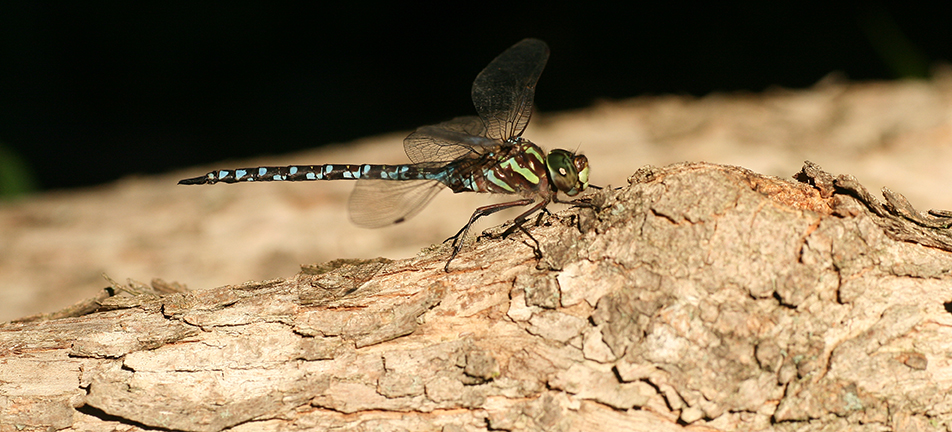
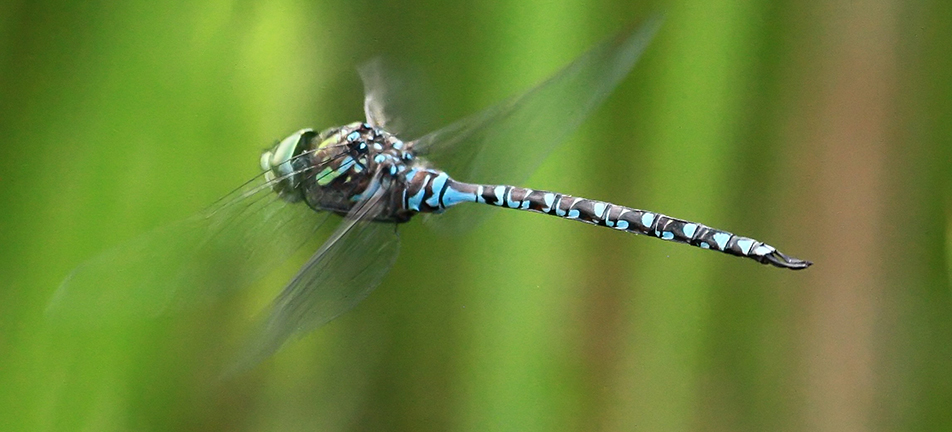
Habitat: lakes, swamps, beaver ponds and streams – often seen patrolling shorelines and in darner swarms
Flight Season: end of June to beginning of October
Range: common across Ontario, except for southwestern Ontario, where it is uncommon
True Fact: The markings on this species darken when it is cold becoming brown or grey instead of blue, green or yellow.
Scientific name: Boyeria vinosa
Length: 60 -71 mm
Description: fairly uniform brown, two bright yellow to white spots on each side of thorax, smaller and paler yellowish spots on abdomen, wings dark brown at base
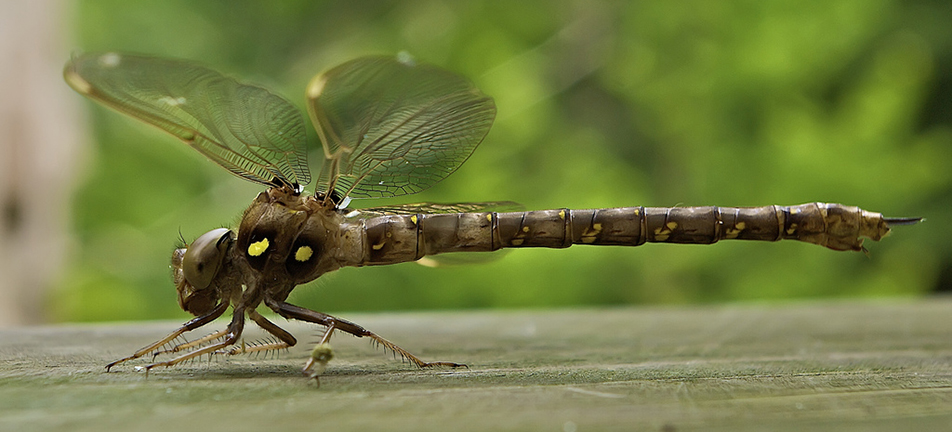
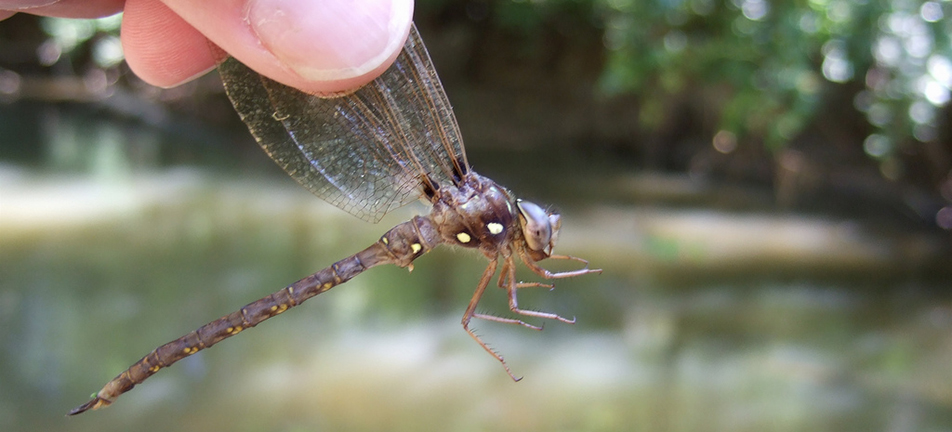
Habitat: shady streams and rivers, adults may also patrol ponds and lakes
Flight Season: June to October
Range: southern and central Ontario, west to Manitoba but south of boreal forest and absent north of Lake Superior
True Fact: This species may land on people’s legs while attempting to lay eggs (this is the source of the myth that dragonflies sting).
Scientific name: Anax junius
Length: 68 – 98 mm
Description: solid green thorax (hence name), abdomen bluish for males and reddish-brown for females
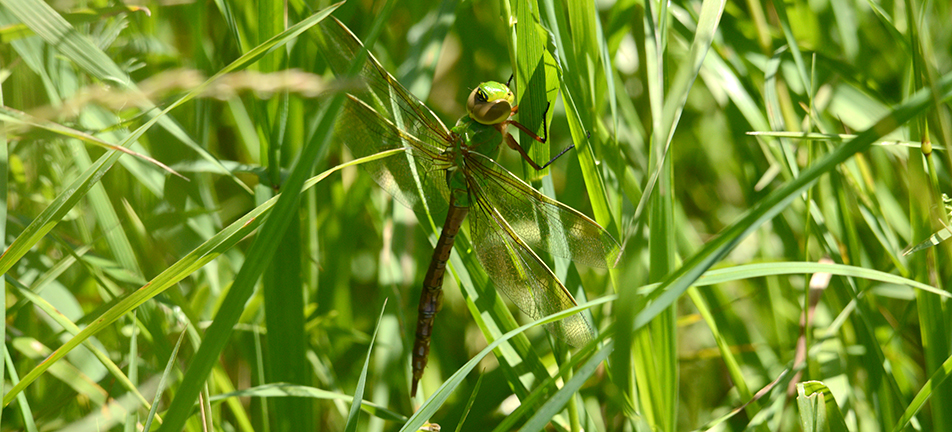

Habitat: lakes, ponds, marshes, slow streams
Flight Season: May to October
Range: southern and central Ontario to north shore area of Georgian Bay, west to Lake of the Woods areabut south of the boreal forest
True Fact: A large proportion of this species is migratory. Green darners returning from migration are often seen earlier in spring than other dragonflies. Their larvae develop in summer, emerge late in the season and fly south to the southern United States, Mexico or the Caribbean before returning in spring. This species is the only North American darner that usually lays eggs (oviposits) while the male clasps the female, flying in tandem.
Scientific name: Aeshna constricta
Length: 65 – 73 mm
Description: male and female with blue to green diagonal stripes on thorax, not outlined in black, abdomen with many bold blue marks (female may have green or yellow marks), cerci (paired,finger-like extensions on tip of abdomen) large and lance -shaped (hence name) on females
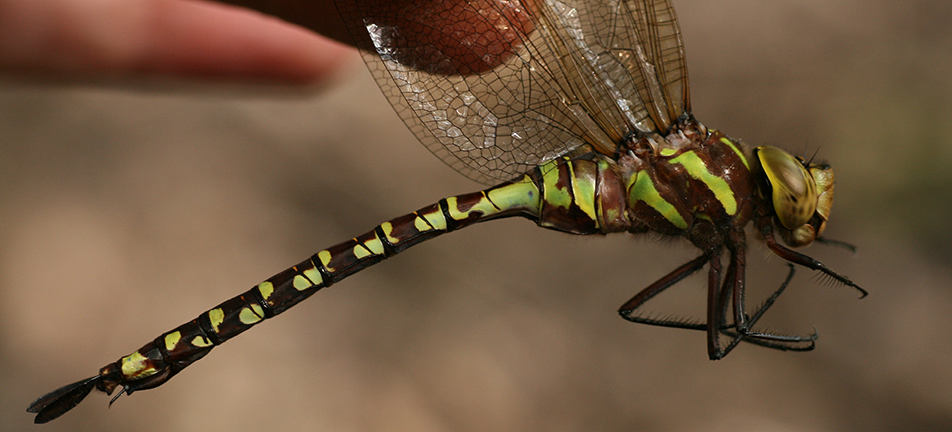
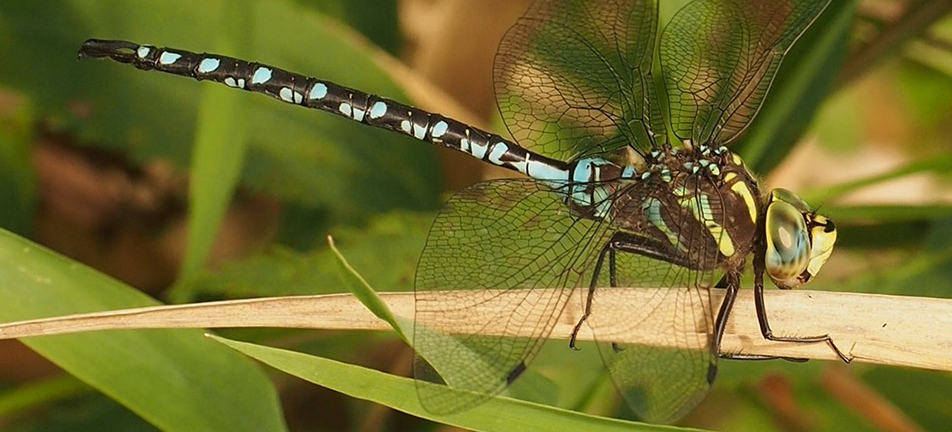
Habitat: often in seasonal ponds, especially marshy ponds and slow-moving streams
Flight Season: July to October
Range: southern and central Ontario to the northeastern shore of Lake Superior, and also reported from Lake of the Woods area
True Fact: Females are as brightly coloured as the males, and patrol over water like them, perhaps to avoid harassment. To avoid overtures from other amorous males, females will sometimes fly with their abdomens inclined downward.
Scientific name: Aeshna umbrosa
Length: 64 – 73 mm
Description: relatively dark darner, thorax with stripes outlined in black, light markings on abdomen pale and fairly small
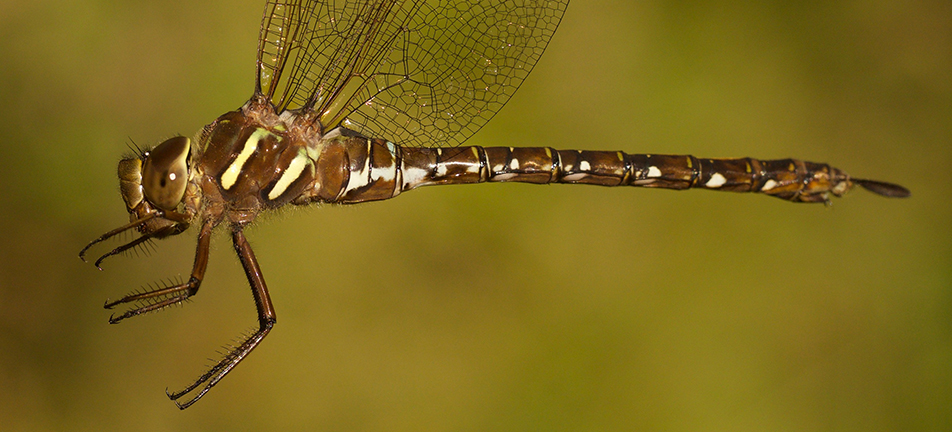
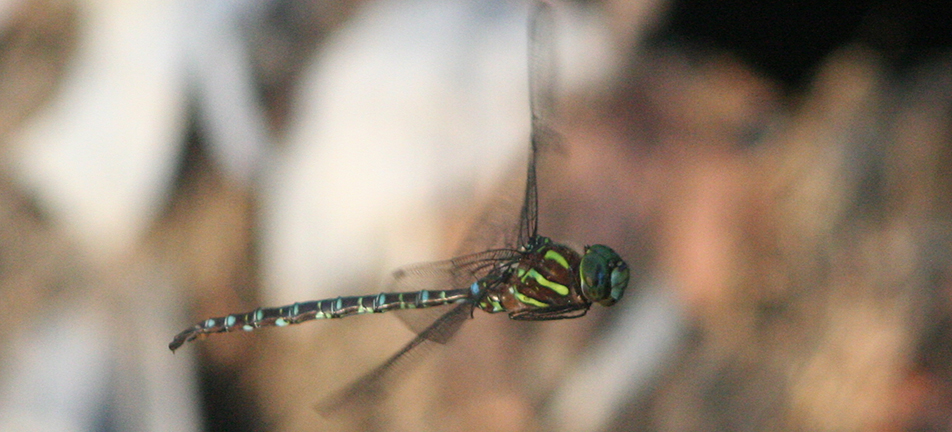
Habitat: somewhat shaded streams, ponds, and other water bodies, adults may be found in upland clearings and other open areas
Flight Season: June to October
Range: throughout Ontario except extreme northwest
True Fact: This species is one of the last seen in autumn. It regularly flies in shaded areas and is active until dark.
Scientific name: Basiaeschna janata
Length: 53 – 64 mm
Description: fairly small early-season darner, thorax with bright yellow to white diagonal stripes, abdomen blue-spotted (may be green-spotted for females).
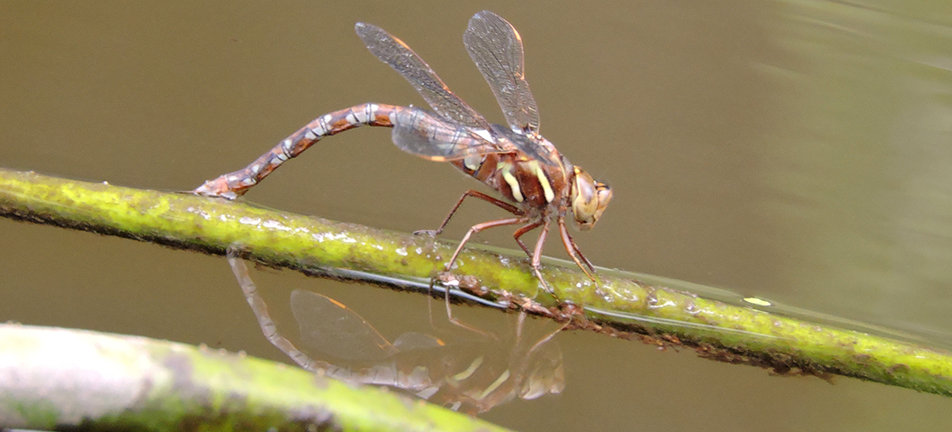
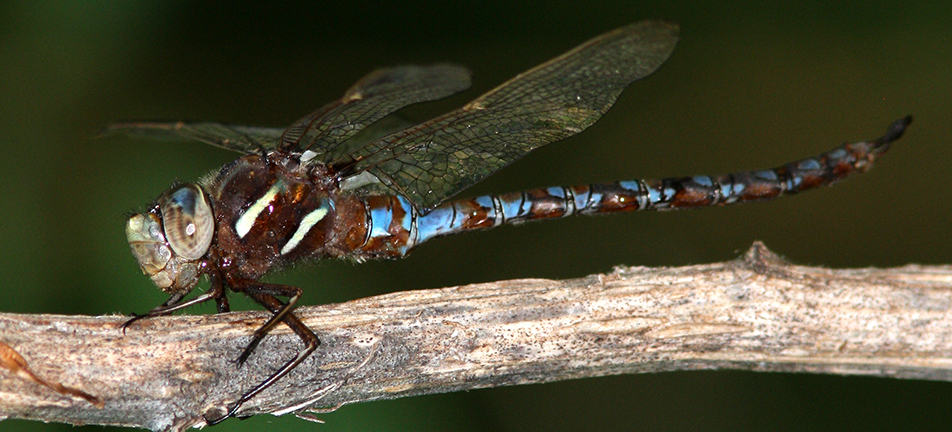
Habitat: prefers forest lakes and ponds, and shaded, gently-flowing rivers and streams
Flight Season: May to July
Range: throughout Ontario north to southern boreal forest area
Family Gomphidae (Clubtails)
These dragonflies are named for the enlarged posterior abdominal segments in many species (most pronounced in males, females have a somewhat thicker abdomen).
Scientific name: Hagenius brevistylus
Length:73 – 90 mm
Description: large dragonfly, black and yellow, long legged, small head, in flight abdomen tip may be curled down; male with green eyes, yellow face, thorax boldly striped yellow and black, abdomen black with yellow patches on sides of basal segments and near tip of abdomen with small yellow side spots in between; female similar colour and pattern to male but much more yellow on abdomen sides

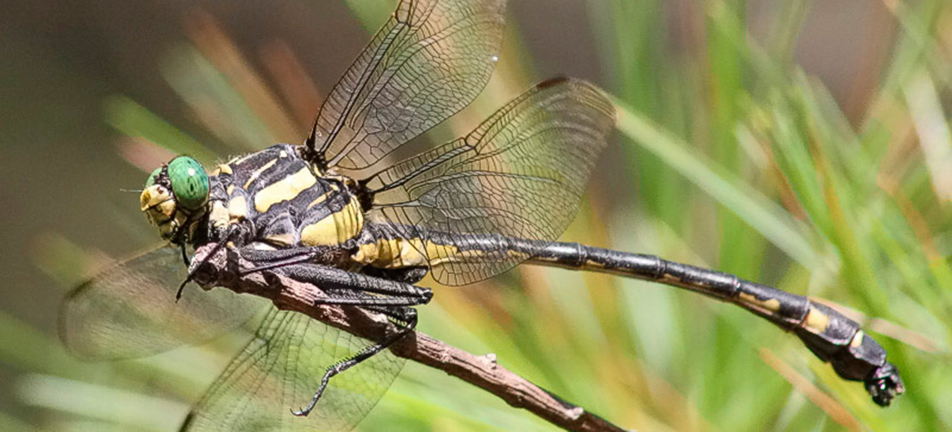
Habitat: usually streams and rivers with moderate to fast current, sometimes lakes
Flight Season: June to September
Range: throughout the Great Lakes region west to Manitoba, including southern edge of boreal forest
True Fact:This species is well named, as it preys on dragonflies and damselflies. A particular favourite is reported to be the ebony jewelwing damselfly. They also prey on butterflies. This species is the largest of the clubtails.
Scientific name: Ophiogomphus colubrinus
Length: 41 – 48 mm
Description: bright green with distinct markings, dark facial stripes; male eyes green crossed by four narrow black lines, thorax mostly green, brownish abdomen with many greenish spots, enlarged “club” at tip; female similar coloration but abdomen thicker with less prominent club at tip, sides of abdomen marked with white
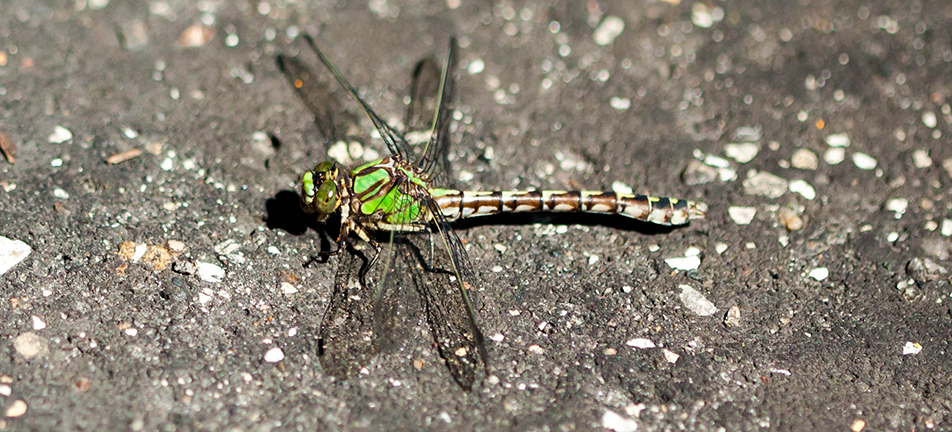
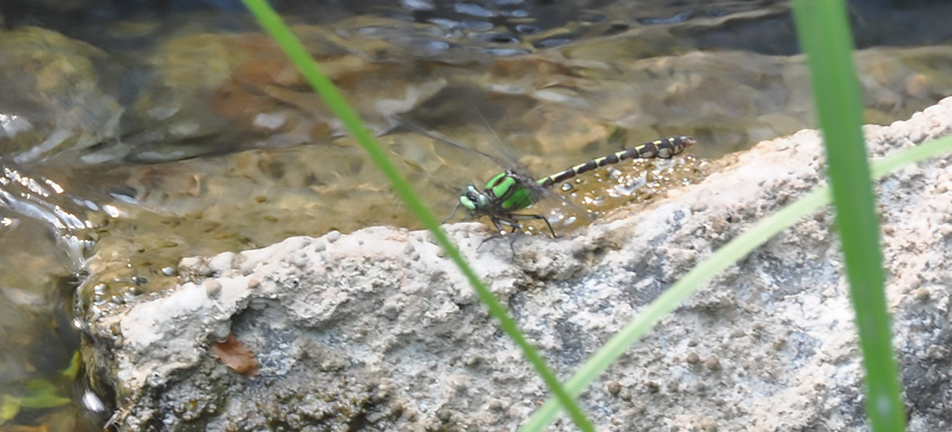
Habitat: clear, fast-flowing streams and rivers with gravelly or rocky beds
Flight Season: May to September
Range: all of Ontario north of Georgian Bay from Ottawa River in the east to Manitoba border in the west
True Fact: This northerly species is most active in morning and mid-afternoon, not mid-day. Females lay eggs in riffles or upstream of riffles in fast-moving streams and rivers.
Scientific name: Gomphus spicatus
Length: 46 – 50 mm
Description: fairly slender clubtail, blue eyes, thorax with black and yellow stripes, abdomen mostly black with yellowish, rear-pointed markings, overall greyish (females may be brown as well)
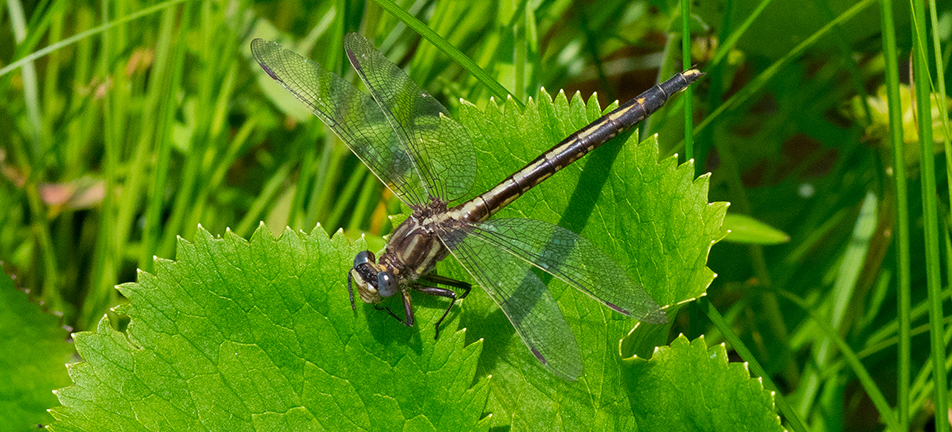
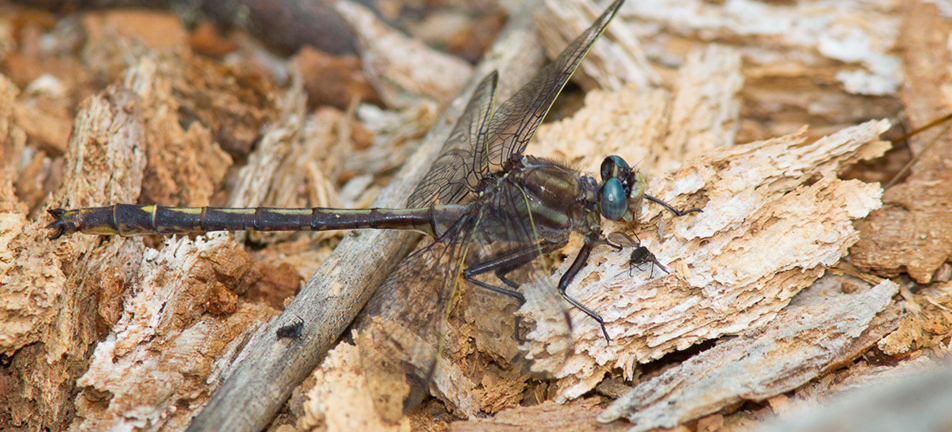
Habitat: prefers marshy or boggy ponds and lakes
Flight Season: May to August
Range: throughout Ontario extending into boreal forest
True Fact: While newly-emerged adults and mature females hunt in woodland clearings, males perch along the shore on the ground, on water lily pads or other low vegetation.
Scientific name: Arigomphus furcifer
Length: 46 – 54 mm
Description: fairly slender, eyes blue, black stripes on thorax, abdomen with yellowish marking

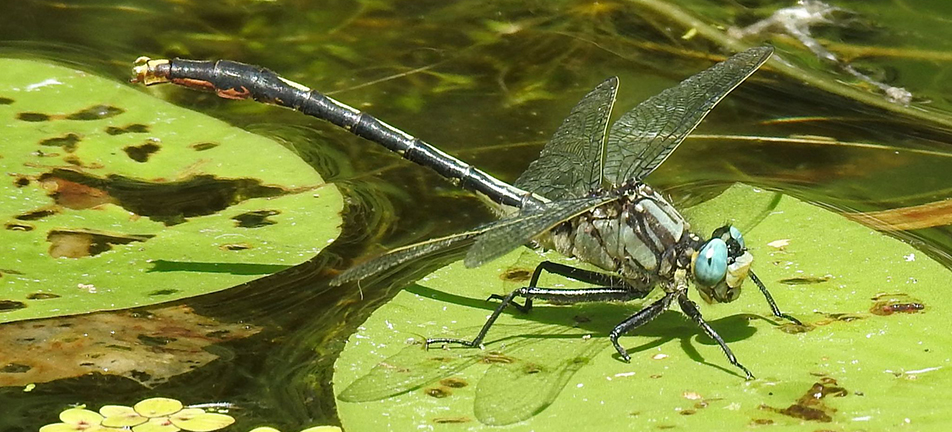
Habitat: lakes, ponds and slow-moving streams with floating vegetation such as lily pads
Flight Season: May to August
Range: through southern Ontario to south part of Georgian Bay
True Fact: As its name suggests, males of this species like to perch on lily pads, but also on other low vegetation, rocks and sandy shores.
Family Cordulegastridae (Spiketails)
Large dragonflies, with black to brown bodies and with conspicuous yellow markings on the thorax and abdomen, are typical of the Spiketail family.
Scientific name: Cordulegaster obliqua
Length: 72 – 81 mm
Description: large spiketail, eyes green, thorax dark brown with two bold yellow stripes on each side and two smaller ones on the front, abdomen black with striking yellow arrowhead markings on abdomen; female similar but with long, pointed ovipositor extending beyond tip of abdomen (therefore named spiketail)
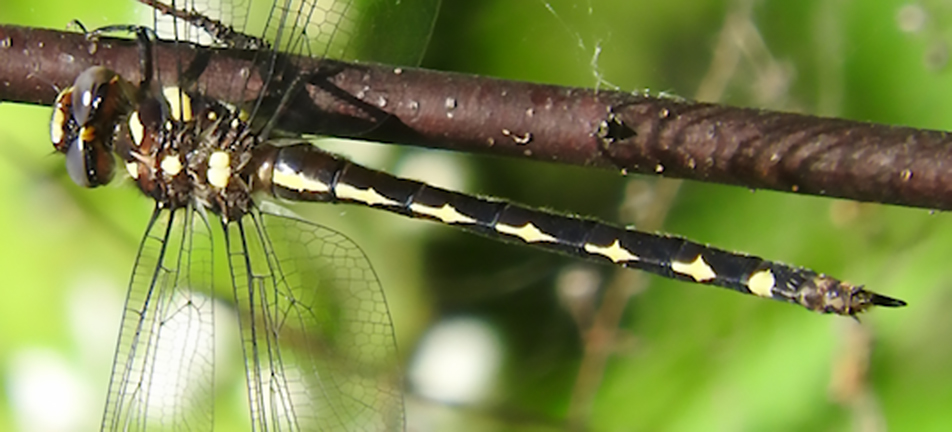
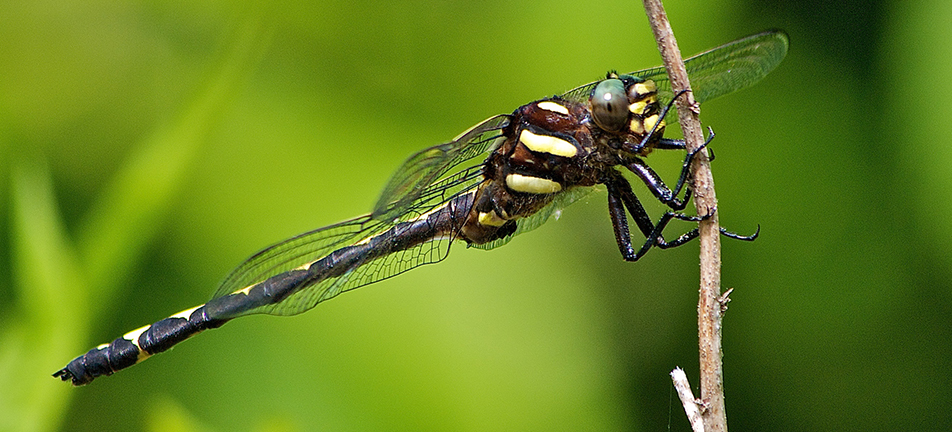
Habitat: small, usually muddy streams in forests, often in streams with only a series of pools in drier weather, often in areas where skunk cabbage is present
Flight Season: May to July
Range: southern Ontario to north shore of Georgian Bay, west to Sault Ste Marie area
True Fact: Males perch on twigs or stems along water or patrol by flying low, and often cover the entire length of small streams. A meeting between males will often result in a chase or sometimes a mid-air fight, with each attempting to seize and bite the other.
Family Corduliidae (Emeralds)
Scientific name: Epitheca cynosura
Length: 38 – 43 mm
Description: small, brownish dragonfly, row of yellow spots along sides of abdomen, eyes red and grey for much of life but bright emerald green when fully mature; small to large basal spot on the wing (near the body); large wing spots on some make their flight seem “fluttery”
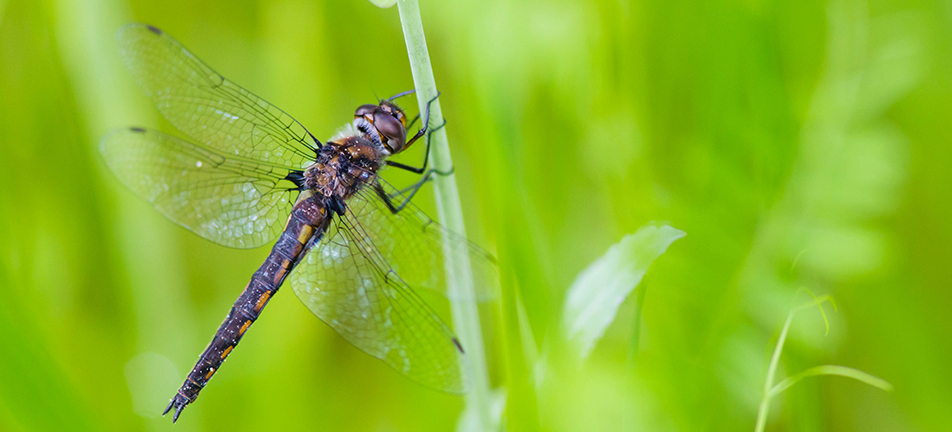
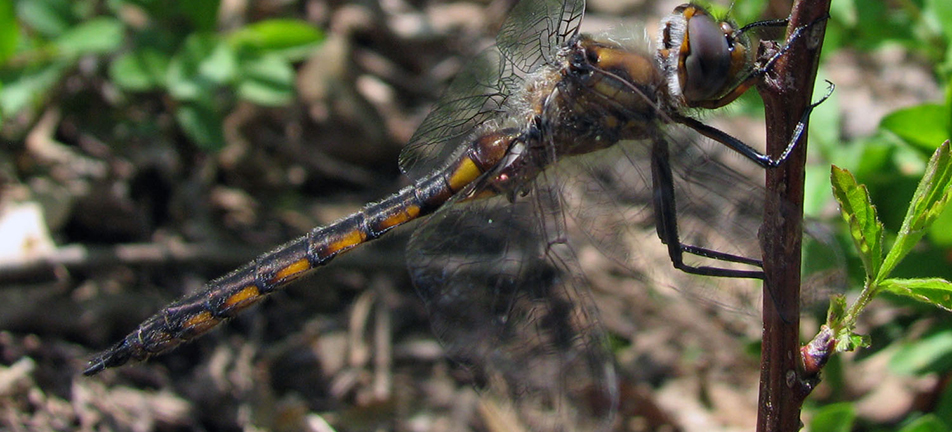
Habitat: marshes and marshy lakes and ponds, slow-moving streams and rivers
Flight Season: May to August
Range: southeastern and southwestern Ontario to north shore area of Georgian Bay; in the northwest Rainy River to Lake of the Woods
True Fact: The patrolling beat of males may be only 15 metres, which he covers by flying back and forth frequently. After mating, the female carries her eggs in a “basket” at the tip of her abdomen, which she places in floating vegetation such as algae.
Scientific name: Epitheca princeps
Length: 59 –75 mm
Description: fairly large and elegant-looking, eyes bright green at full maturity, eyes of female may be red over grey: thorax brown with small yellow spots low on sides, usually with three spots on each wing.
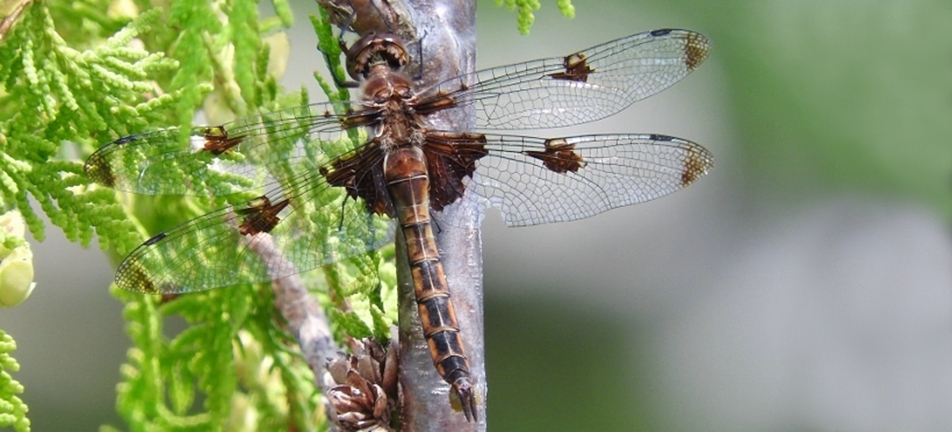
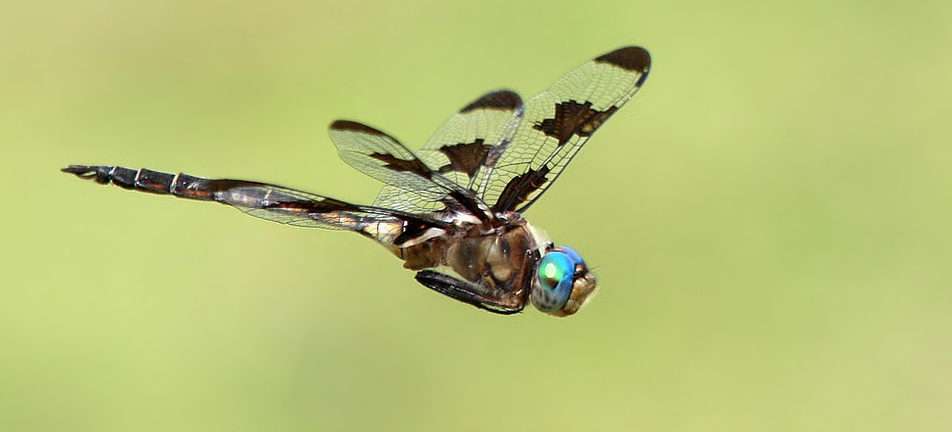
Habitat: quiet waters, in large ponds, lakes and rivers
Flight Season: June to September
Range: throughout southern Ontario to north shores of Georgian Bay, also west of Lake Superior but south of boreal forest
True Fact: This species often feeds in swarms in open areas. Pairs attach while flying over water, and may copulate in flight. Females form an egg mass, then fly over water and drop the mass gradually, dragging out a long string of eggs.
Family Macromiidae (Cruisers)
Fast-flying, usually up and down streams or along lake shores, these large brown to black dragonflies have large eyes (sometimes brilliant green), usually a pale stripe on each side of the thorax, pale spots or rings on the abdomen and long legs.
Scientific name: Macromia illinoiensis
Length: 65-76 mm
Description: a large-sized strong flier, dark brown to black with green eyes, a solitary yellow stripe on each side of thorax and small yellowish spots along the abdomen including a very large spot near the posterior end. The abdomen is slightly clubbed in males
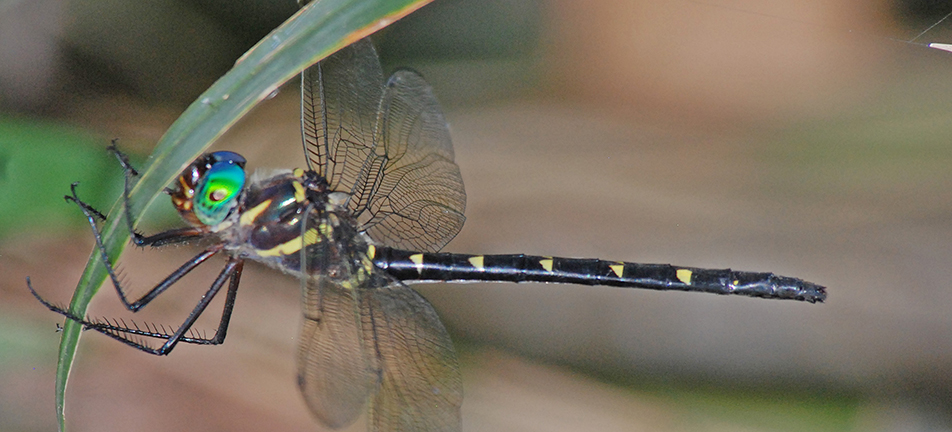
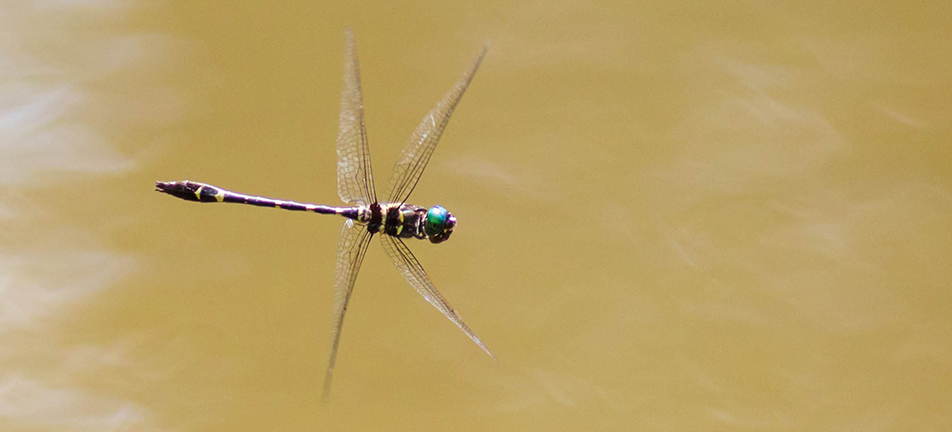
Habitat: streams and rivers with slow to fast currents, muddy to rocky bottoms
Flight Season: June to September
Range: southern and central Ontario to Sault Ste Marie, west from Thunder Bay district to Manitoba border
True Fact: Males are quick, like a missile, when pursuing females in lengthy chases.
Family Libellulidae (Skimmers)
The skimmers are a large, diverse family of brightly coloured dragonflies that often have boldly patterned wings. Large compound eyes come together at the centre of the head, giving a helmet-like appearance.
Scientific name: Erythemis simplicicollis
Length: 38 – 44 mm
Description: medium size skimmer; green face, females and young males have green thorax without black stripes, abdomen with square dark spots, males become bluish grey with maturity
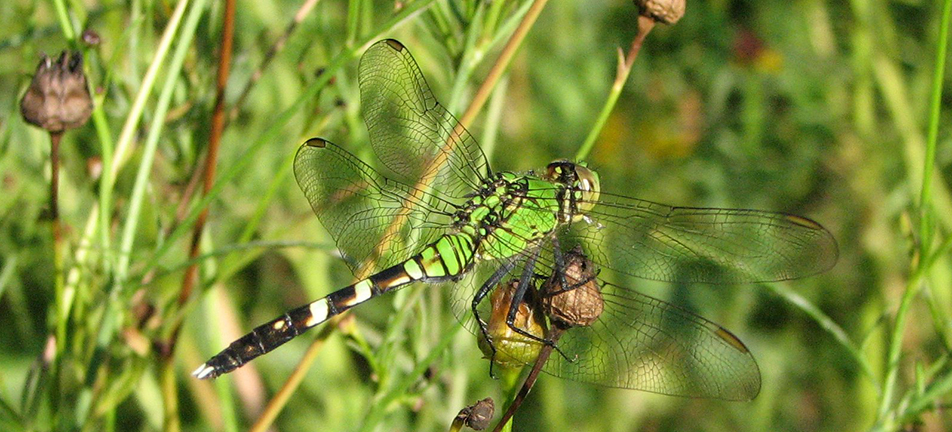
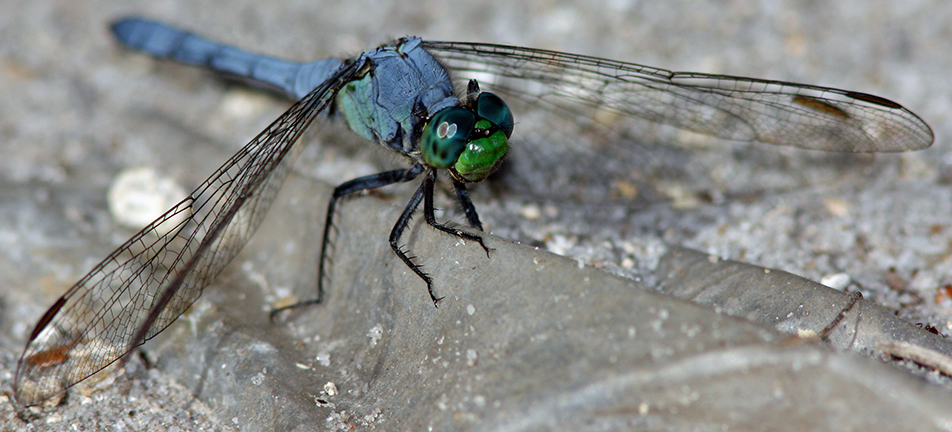
Habitat: quiet waters such as ponds and lakes that have floating vegetation
Flight Season: May to September
Range: southern Ontario to northern shores of Georgian Bay; west of Lake Superior in Rainy River area
True Fact: This species often perches on the ground. In fact, ground-foraging tiger beetles sometimes encounter and eat them. They feed on damselflies and dragonflies from its own size to smaller, foraging until dark.
Scientific name: Ladona julia
Length: 38 – 45 mm
Description: rather stout, black markings at base of wings, lighter-coloured shoulder bars that are white in males, grey in females and tan in newly emerged adults or tenerals, male with white base of abdomen

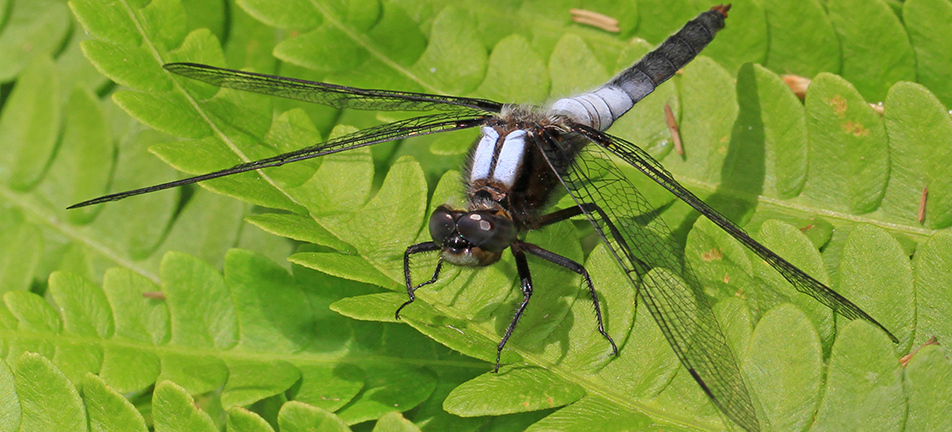
Habitat: lakes and ponds, including bog lakes, prefers muddy bottom
Flight Season: May to September
Range: (throughout southern Ontario, west to the Manitoba border and north into southern reaches the boreal forest
True Fact: This species often perches on the ground and on sides of trees facing the sun. They are often found far from the water. With males guarding by hovering over them, females lay eggs by tapping their abdomen on the water, moving a short distance between taps
Scientific name: Leucorrhinia intacta
Length: 29 – 33 mm
Description: small, male black with white face and yellow dot on abdomen, female and immature dark brown with yellow markings on thorax and abdomen, most posterior mark on abdomen a distinct yellow dot
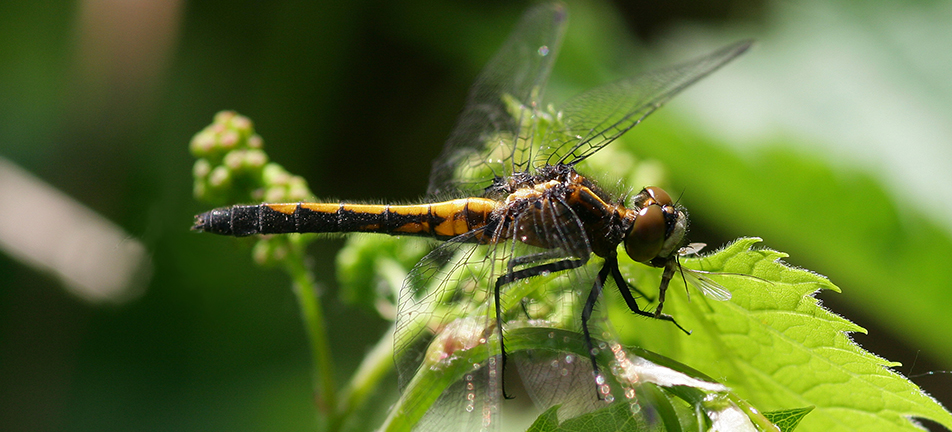
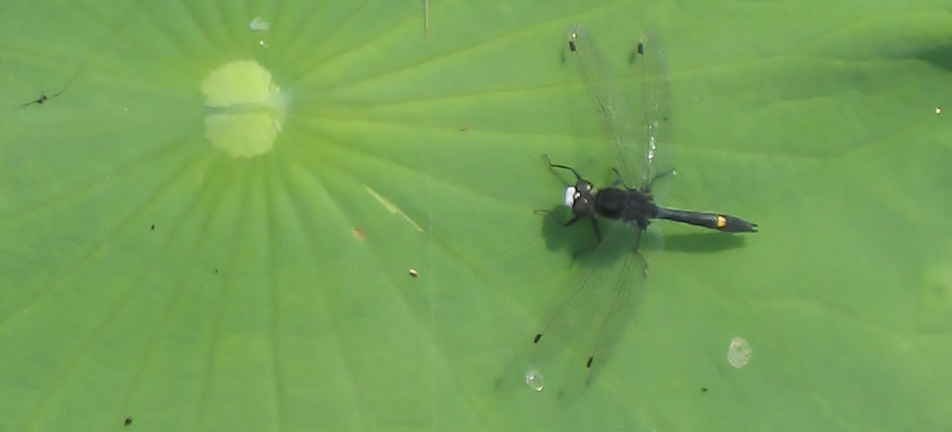
Habitat: lakes and ponds with emergent vegetation
Flight Season: May to August
Range: throughout southern Ontario to north shore of Georgian Bay, west from Lake Superior to Manitoba border
Scientific name: Libellula luctuosa
Length: 42 – 50 mm
Description: males’ wings with wide black basal patches, white marks beyond when mature, dark brown eyes, face and thorax, pale top of abdomen; females lighter in colour, top of abdomen with black stripe becoming broader towards rear, this stripe bordered by yellow stripes
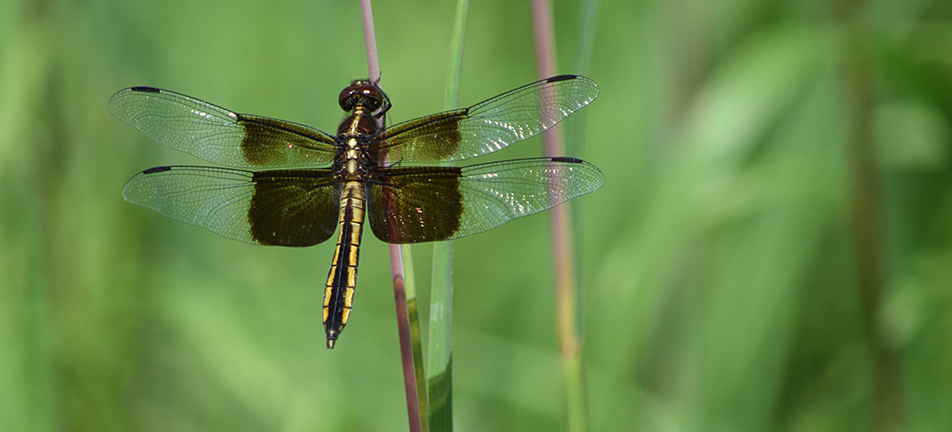
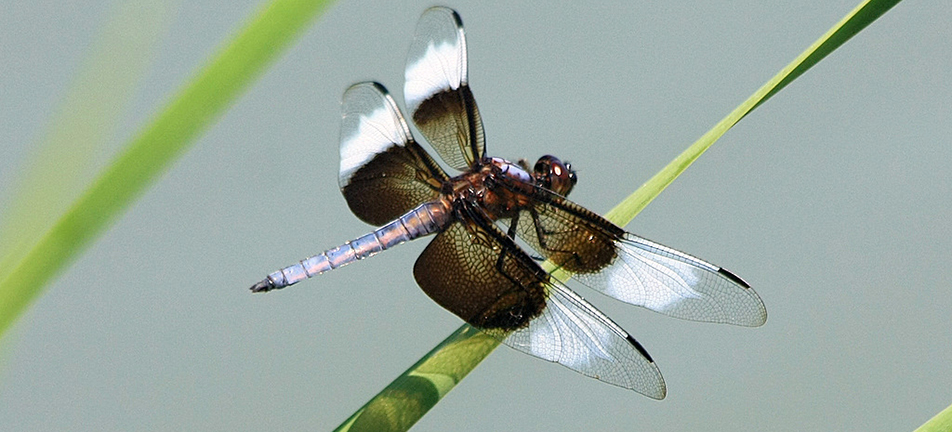
Habitat: slow-moving parts of streams, ponds and lakes, prefers muddy bottoms
Flight Season: May to September
Range: southern Ontario north to southern Georgian Bay
True Fact: While hovering during patrol flights, this species may jerk abdomen up and down. Males and females are commonly seen in open areas quite far from water
Scientific name: Libellula pulchella
Length: 52 – 57 mm
Description: male and female with three black spots on each wing, white patches between these spots in mature male, male with light grey abdomen as it matures, continuous pale stripes along sides of brownish abdomen in female
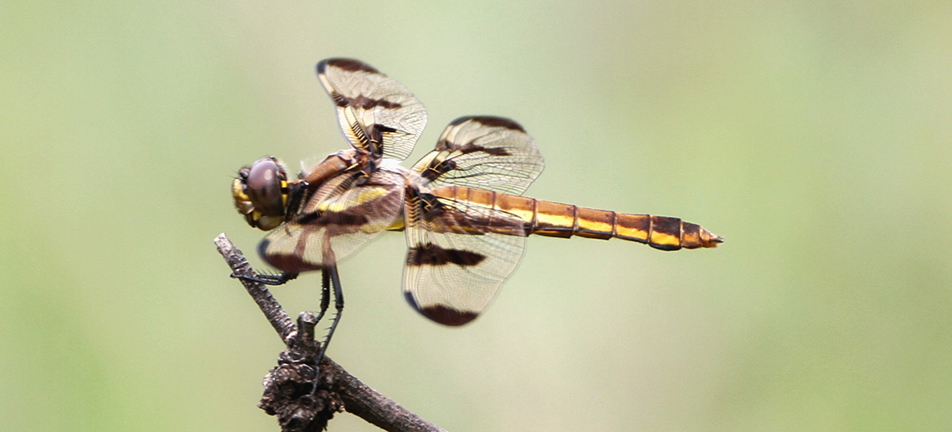
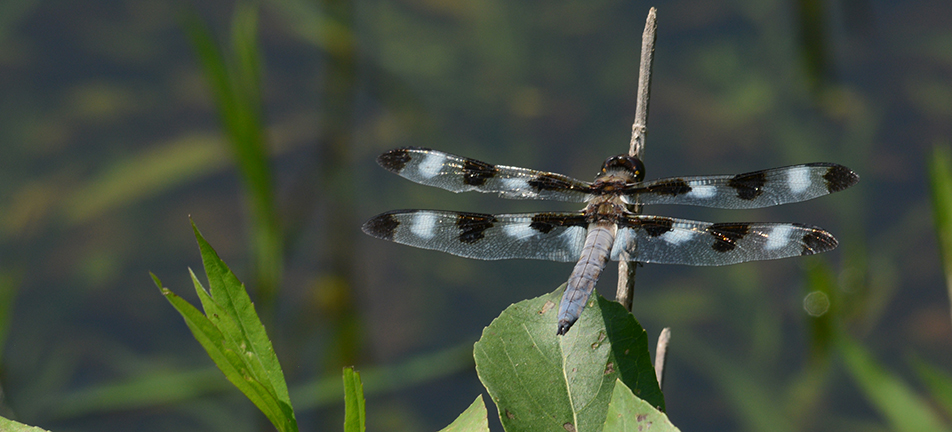
Habitat: lakes and ponds with marshy borders, slow streams
Flight Season: June to October
Range: southern Ontario to north shore of Georgian Bay, west of Lake Superior but absent from its north shore and from the boreal forest
True Fact: Males are aggressive and chase other species and well as their own. During competitive displays, males will hover face-to-face. This species is a strong flier, and large numbers have been seen flying south, so this species is suspected to be migratory.
Scientific name: Pachydiplax longipennis
Length: 28 – 45 mm
Description: fairly small, male with green eyes and striped black and yellow thorax, abdomen becoming blue as it matures and tipped with black; female eyes red but becoming green as it ages, thorax with yellow stripes alternating with black, abdomen with narrow, parallel yellow streaks
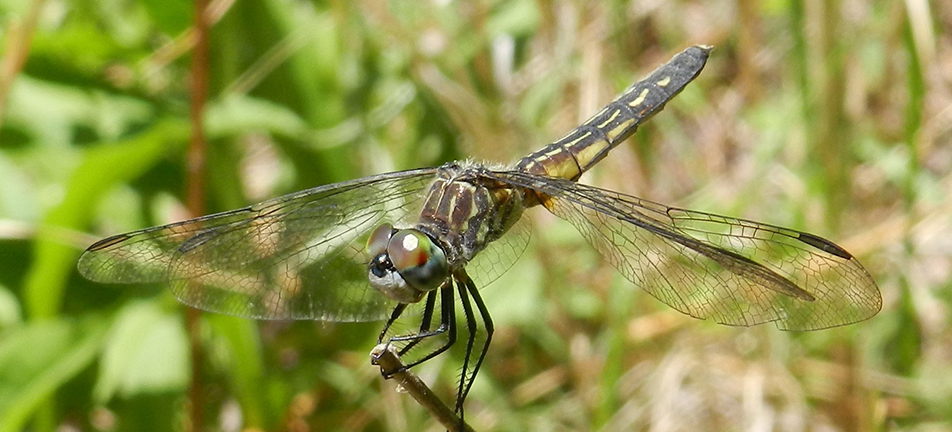
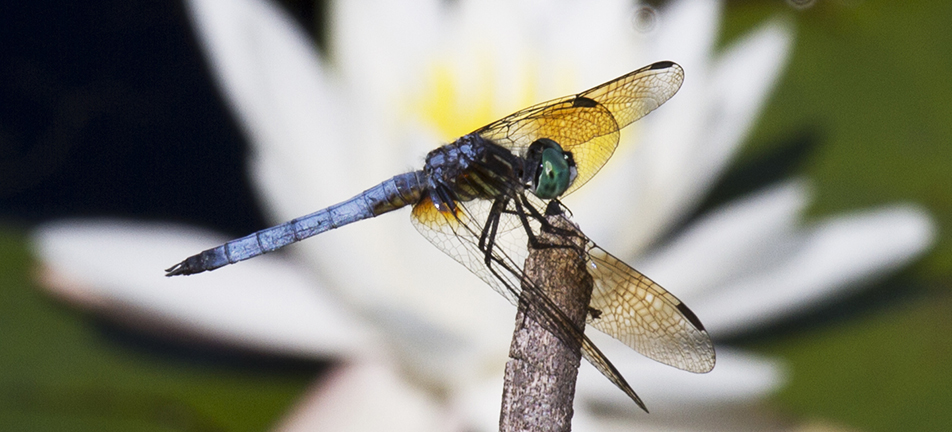
Habitat: ponds, lake bays, marshes, bogs; prefers standing water with aquatic vegetation
Flight Season: May to October
Range: southeastern Ontario along St. Lawrence River to southwestern Ontario, north to southern Georgian Bay; Lake of Woods area west of Lake Superior
True Fact: This species often perches with wings held forward and down, often seen on trees. Both sexes defend small feeding territories away from water.
Scientific name: Plathemis lydia
Length: 42 – 48 mm
Description: eyes and face dark brown, male with white or powder blue abdomen, each wing with wide black patch near wingtip and narrower black stripe at base, female and immature male have brown abdomen with white or yellow triangular spots along sides, female with three black spots on each wing
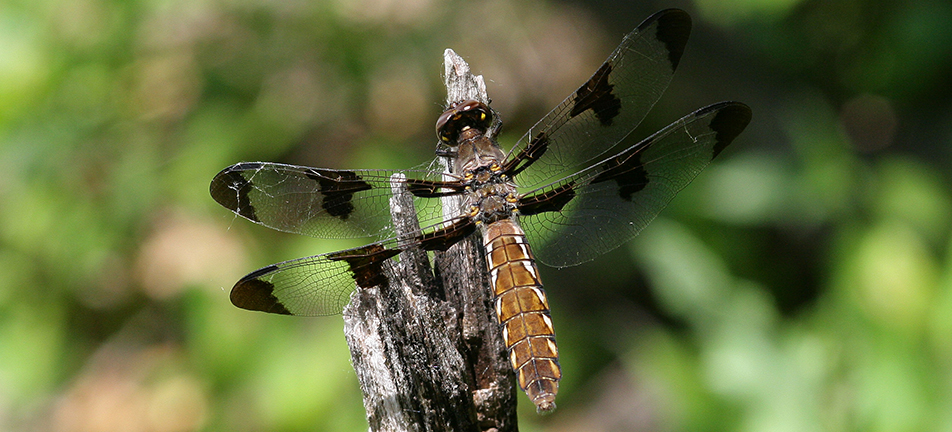
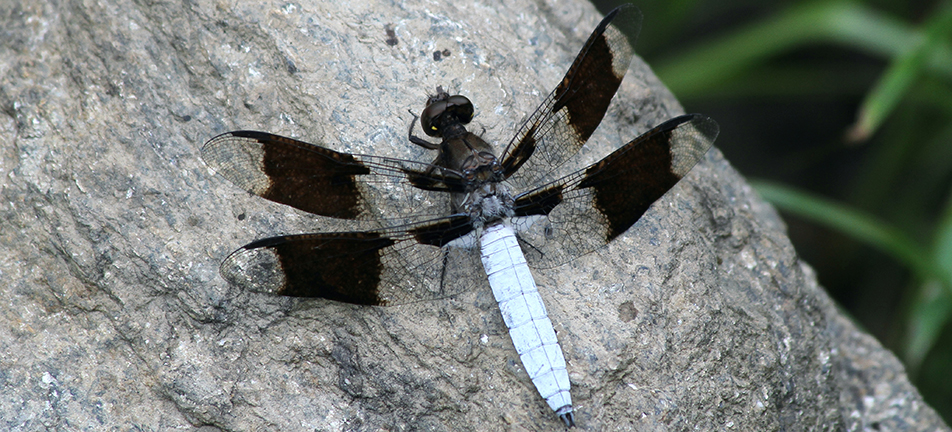
Habitat: almost any standing or slow water body, including ponds and marshes
Flight Season: May to September
Range: southern Ontario to north shore of Georgian Bay, in north west from Rainy River district to Manitoba, absent north of Lake Superior
True Fact: This is a common and widespread dragonfly. Common whitetails often perch on open ground, rocks or logs. They are strongly territorial, and males will elevate abdomens in face to face flight displays.
Scientific name: Sympetrum obtrusum
Length: 31 – 39 mm
Description: mature males appear overall red and black with white face, small orange patch at base of wings, black, triangular, lateral markings on abdomen; females and immature males similar pattern on abdomen but yellowish to brown face
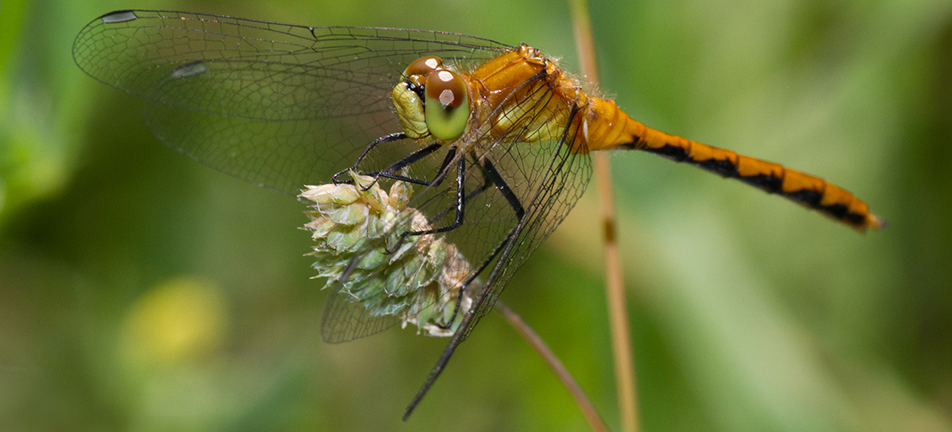
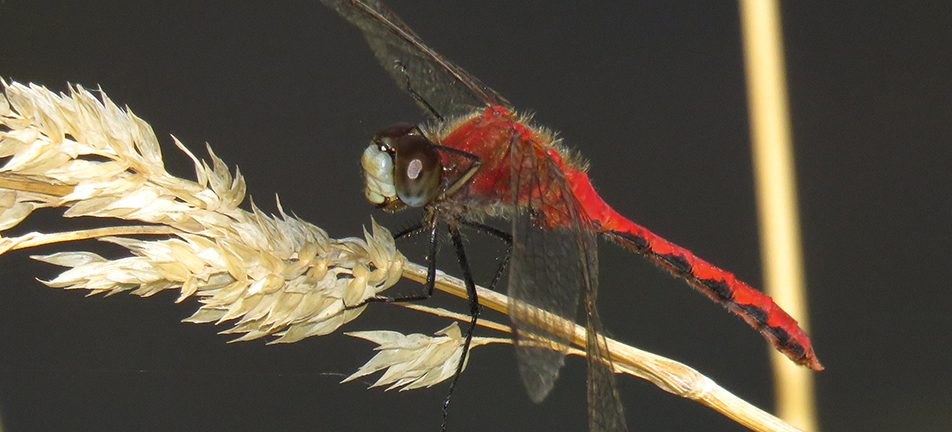
Habitat: ponds, lakes, marshes, bogs, slow streams
Flight Season: June to October
Range: throughout Ontario north to James Bay, absent from extreme northwest
True Fact: This species’ copulation is lengthy, and pairs are often seen in “wheels” (female’s abdomen curled forward beneath male). The eggs are dropped from above into shallow water or in dry areas that will flood later in fall or spring.
Scientific name: Sympetrum rubicundulum
Length: 33 – 34 mm
Description: male overall red with sharply contrasting black triangular markings on abdomen, light brown or yellowish face; female tan or olive in colour; difficult to distinguish from white-faced meadowhawk in field
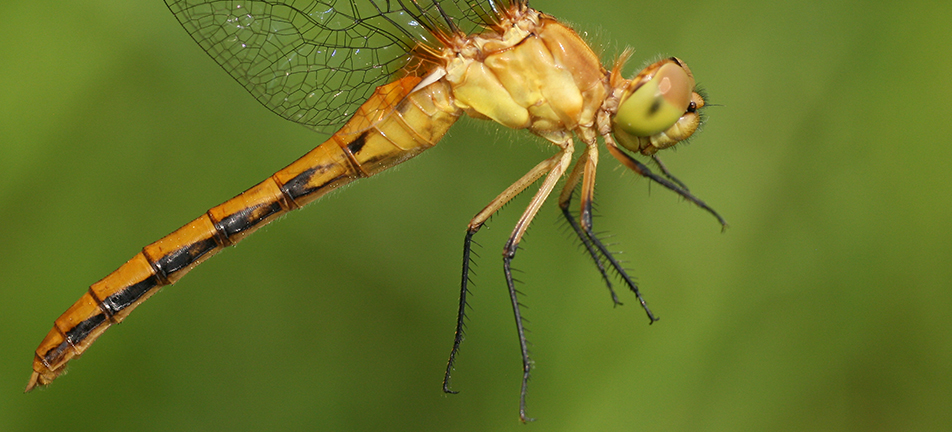
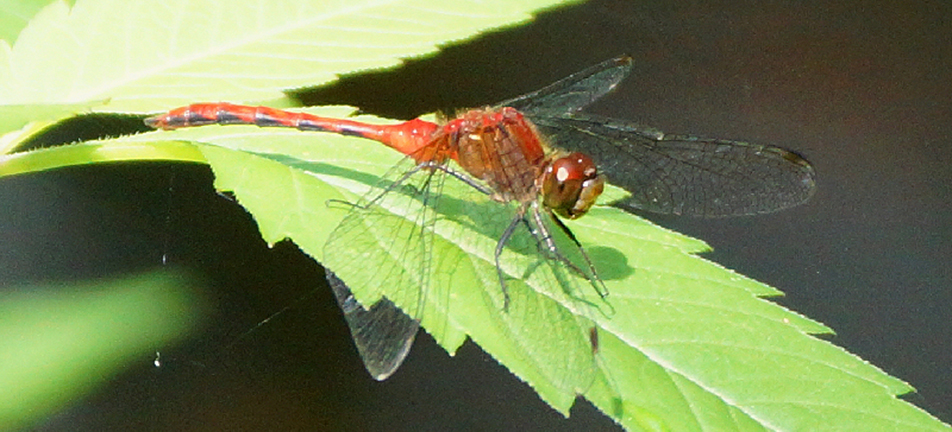
Habitat: marshes and marshy ponds, ditches and lakeshores
Flight Season: June to September
Range: southern Ontario north to southeastern shores of Georgian Bay
True Fact: This species oviposits by dropping eggs into vegetation along water, and also lays eggs directly in water.
Scientific name: Sympetrum vicinum
Length: 31 – 35 mm
Description: male overall red, abdomen with less black than most other meadowhawks, female yellowish with a projecting scoop, the sub genital plate, near the tip of the abdomen (visible in side view). Unlike other adult meadowhawks, this species has yellow or light brown legs.
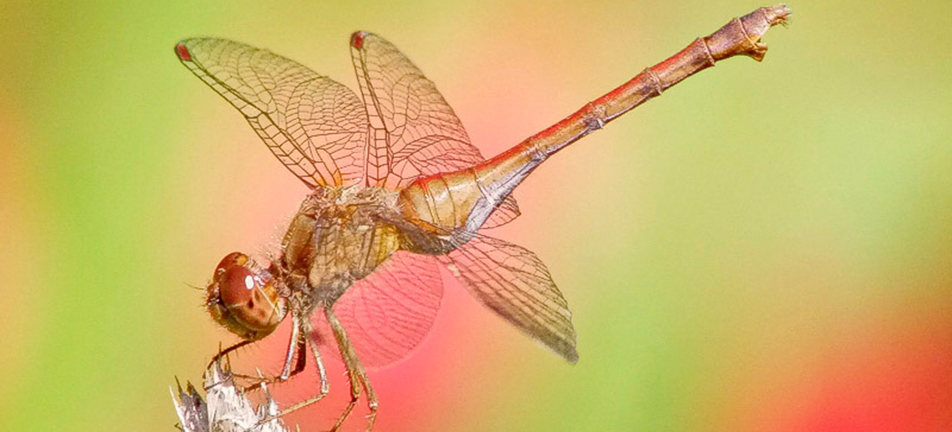
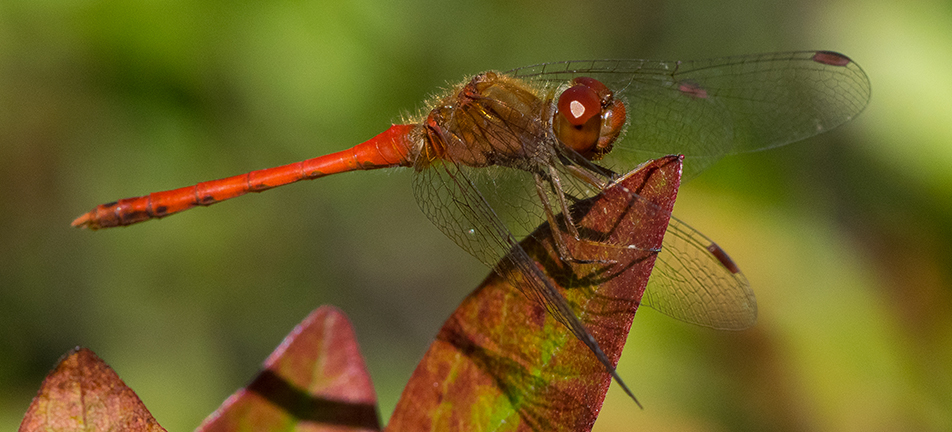
Habitat: ponds, lakes, slow streams, wooded habitats
Flight Season: July to November
Range: southern Ontario to north of Georgian Bay, in far west Rainy River to Lake of the Woods
True Fact: This species flies late into autumn, until the first heavy frost. The females form balls of eggs, which the pair in tandem drop from several centimetres up.
Scientific name: Tramea lacerata
Length: 51 – 55 mm
Description: hind wings with broad black band near base (some suggest they resemble theatre comedy masks facing each other across the abdomen), overall black or dark brown appearance, yellow squarish marks near tip of abdomen, female and immature male show more yellow dorsally on abdomen
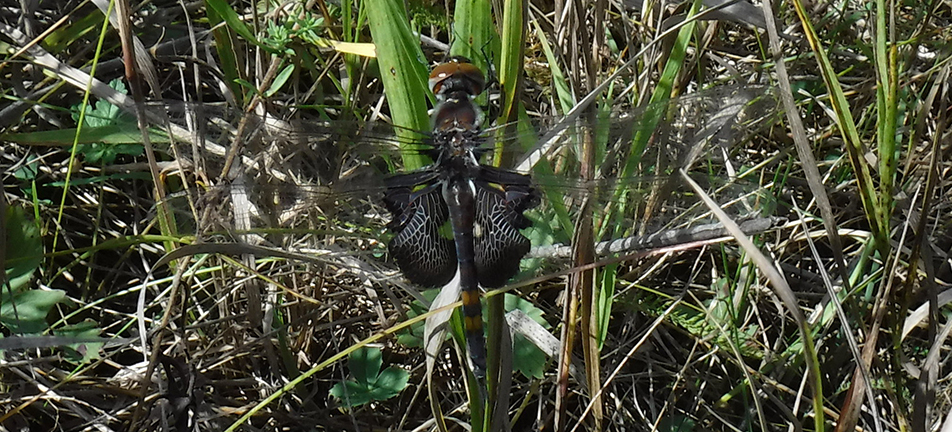
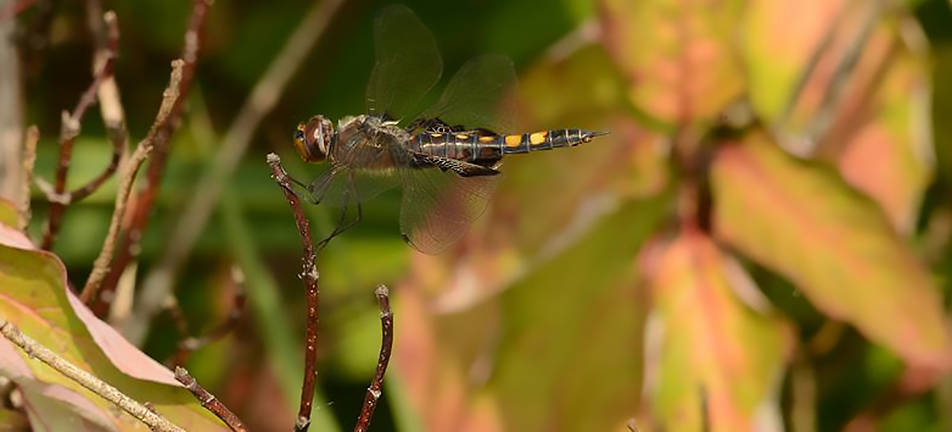
Habitat: shallow open lakes, ponds, ditches with much vegetation, including temporary ponds
Flight Season: May to October
Range: southern Ontario to south shore of Georgian Bay and Bruce peninsula
True Fact: This species has a large territory, often exceeding 30 metres along shoreline. As it flies over, the black bands (saddlebags) can be observed to identify this species. They are very migratory, often found with green darners in autumn swarms.
Scientific name: Perithemis tenera
Length: 20 – 25 mm
Description: small, stocky dragonfly with orange legs. The orange-brown abdomen is spindle-shaped with pale narrow rings. The male’s wings are uniformly orange with red stigmas; whereas the female’s wings are clear with brown patches
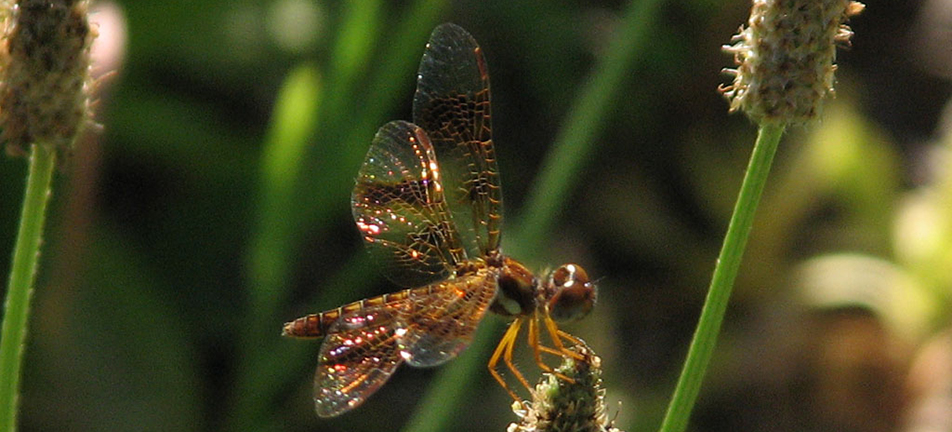
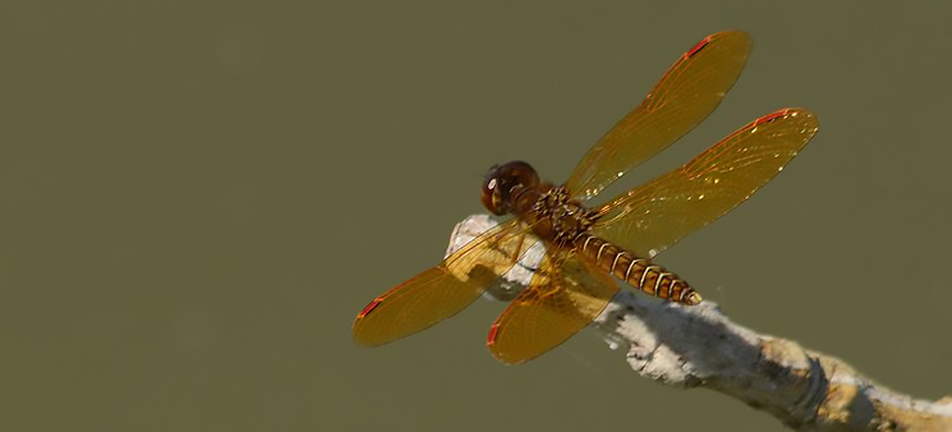
Habitat: wetlands, lakes and slow streams
Flight Season: June to September
Range: typically found in Ontario’s Carolinian area, southern Ontario and eastern Ontario
True Fact: Often mimics wasps by pumping its abdomen and waving its wings up-and-down.
Scientific name: Celithemis eponina
Length: 36 – 42 mm
Description: wings are pale orange with rusty-brown spots; males have red-orange stigmas and the top of the male’s abdomen has orange/red markings, females and immature males have yellow markings
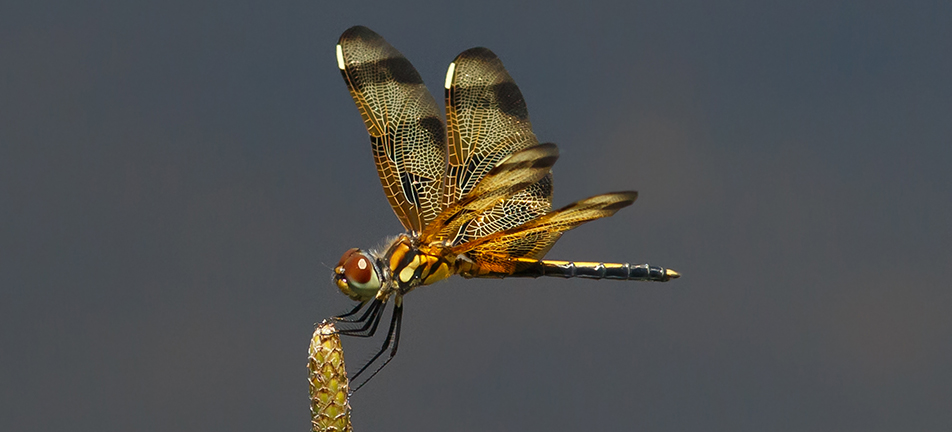
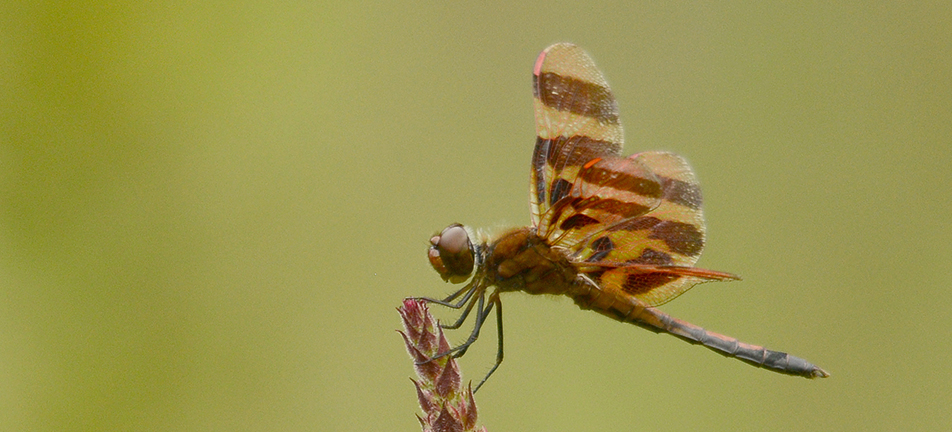
Habitat: often seen perched on the tips of twigs and other vegetation sometimes far from water
Flight Season: beginning of June to end of September
Range: usually found south of the Canadian Shield
True Fact: When perched atop vegetation, the forewings are often held higher than the hindwings. Butterfly-like flight.
Damselflies
Family Calopterygidae (Broad-winged Damselflies)
This showy group of damselflies possess wide, heavily-veined wings which taper gradually at the base and are not stalked or petioled. The coloured wings, usually black, are held closed or together over the top of their metallic-coloured bodies. On hot days, broadwings are the only damselflies to obelisk by holding their abdomens toward the sun.
Scientific name: Calopteryx maculata
Length: 39 – 57 mm
Description: large damselfly with metallic green body, male has black wings; female has white dot at tip of brownish wings
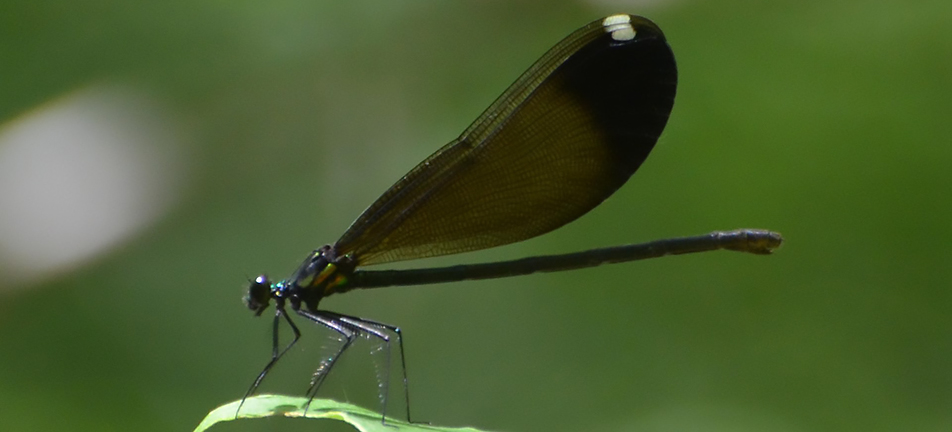
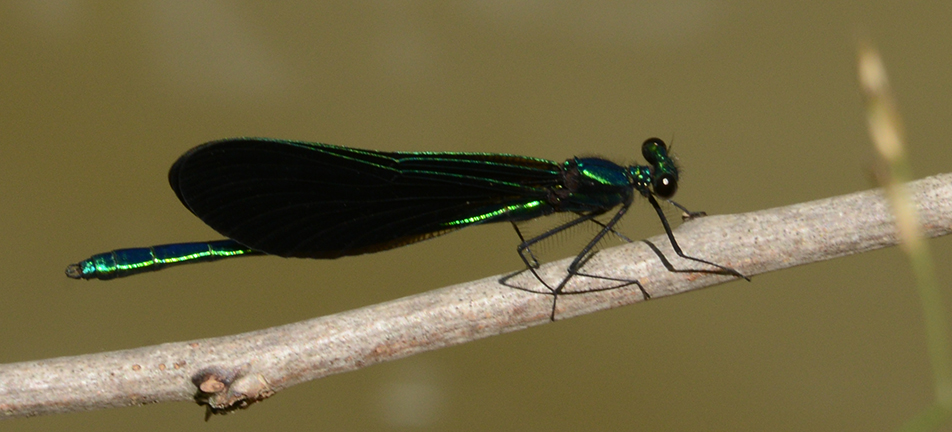
Habitat: edges of often shaded streams and rivers
Flight Season: May to September
Range: throughout southern Ontario, from Lake Superior west to Manitoba south of boreal forest
True fact: in partly shaded places, males perch in sunny locations to be even more obvious
Scientific name: Calopteryx aequabilis
Length: 43 – 59 mm
Description: large damselfly with metallic green body, male has translucent wings with a dark black section at the tip of wing; female, similar to male; translucent brown wings and a white dot at the very tip of the wings
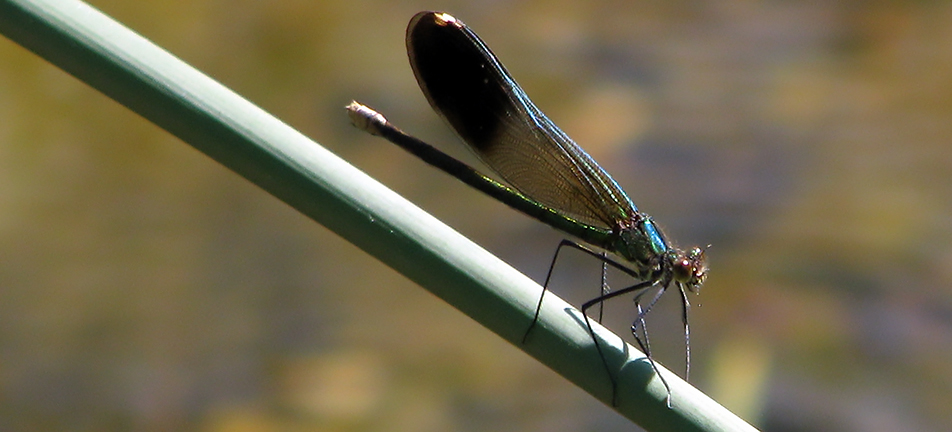
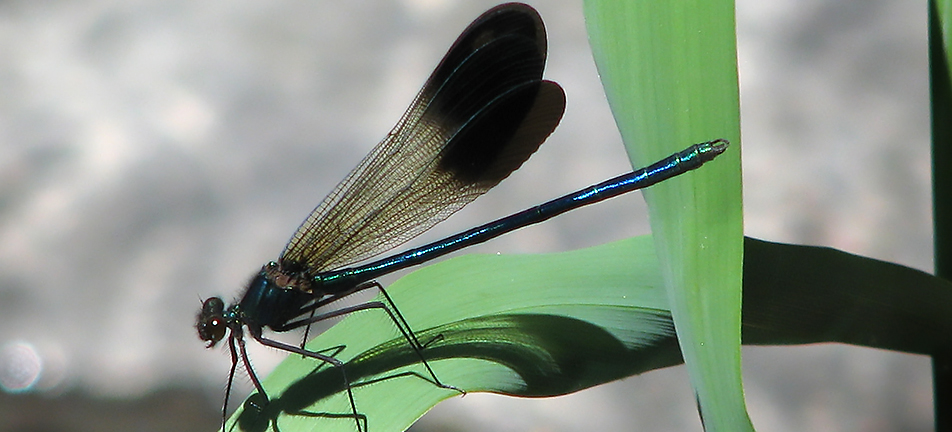
Habitat:along streams and rivers and nearby forest edge
Flight Season: May to September
Range: throughout Ontario
True fact: River jewelwings can easily be differentiated from ebony jewelwings, where ebony jewelwings have entirely dark wings, river jewelwings’ wingtips look like they have been dipped in ink.
Scientific name: Hetaerina americana
Length: 38 – 46 mm
Description: large damselfly, male has bright red patch at base of wings, female usually with paler orangeish wash at base of wings, male and female with small white spot at tip of wings
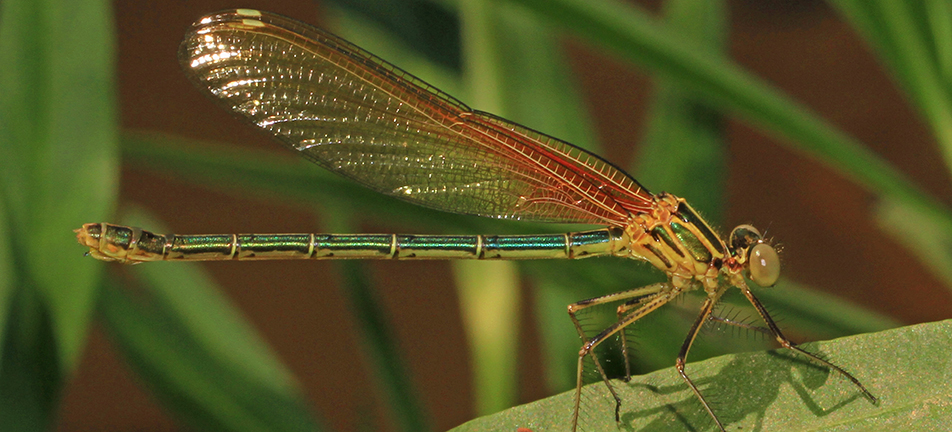
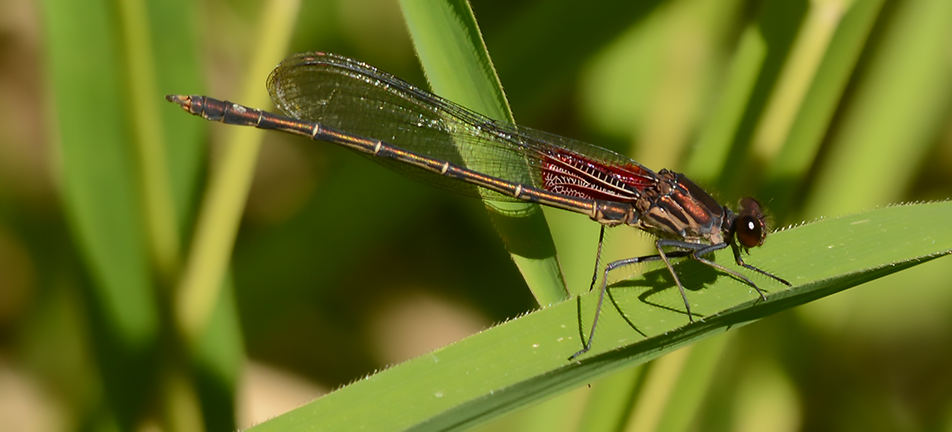
Habitat: streams and rivers with emergent vegetation
Flight Season: June to October
Range: southwestern Ontario
True fact: Groups of this species congregate at dusk during emergence of mayflies.
Family Lestidae (Spread-winged Damselflies)
Species of this family of damselflies possess stalked, clear wings which are held spread-out and slightly to the side.
Scientific name: Lestes dryas
Length: 32 – 40 mm
Description: rather stocky body, top of thorax and abdomen in male bright metallic green, thorax pale on sides, female duller than male but top of thorax metallic green with pale sides, top of abdomen metallic green
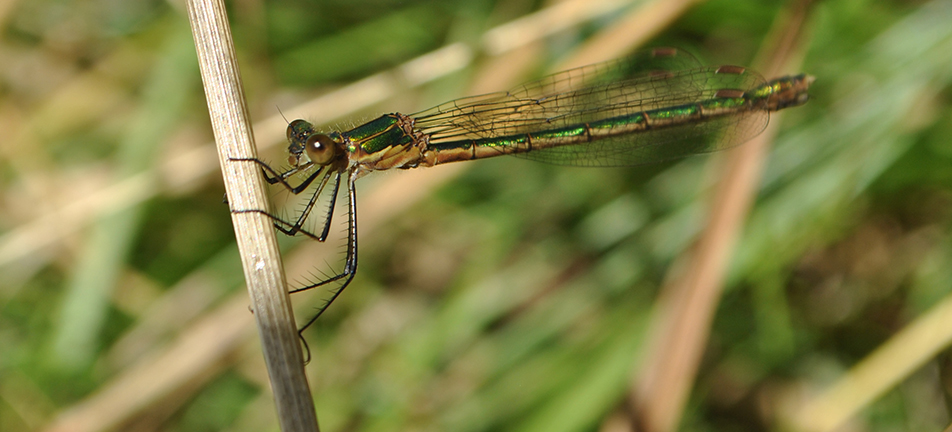
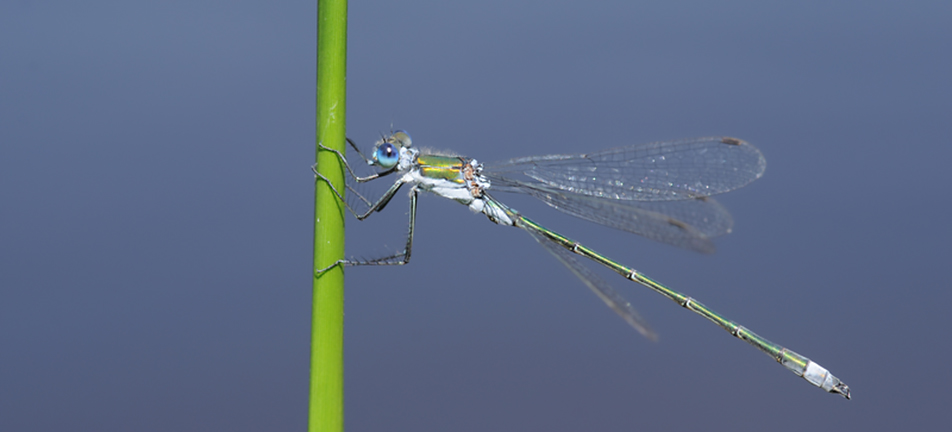
Habitat: shallow ponds and marshes that often dry up in late summer
Flight Season: May – September
Range: southwestern and southeastern Ontario
True Fact: Like other spreadwings, as their name suggests they perch with wings somewhat outstretched. This makes them the exception to the “rule” that damselflies perch with wings folded back tightly over their abdomen.
Scientific name: Lestes forcipatus
Length: 33 – 44 mm
Description: similar to other spreadwings, female with large ovipositor, only species with tip of ovipositor (egg-laying appendage) extending to or beyond tip of cerci (paired, finger-like appendages or projections at the tip of the abdomen).
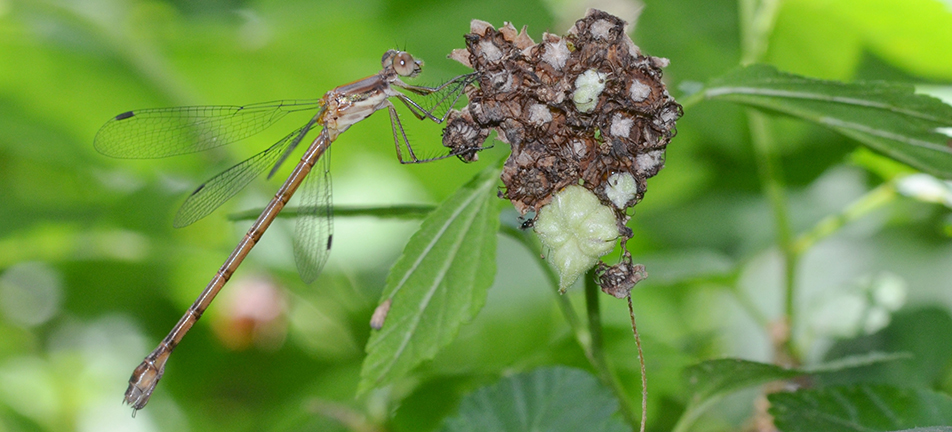
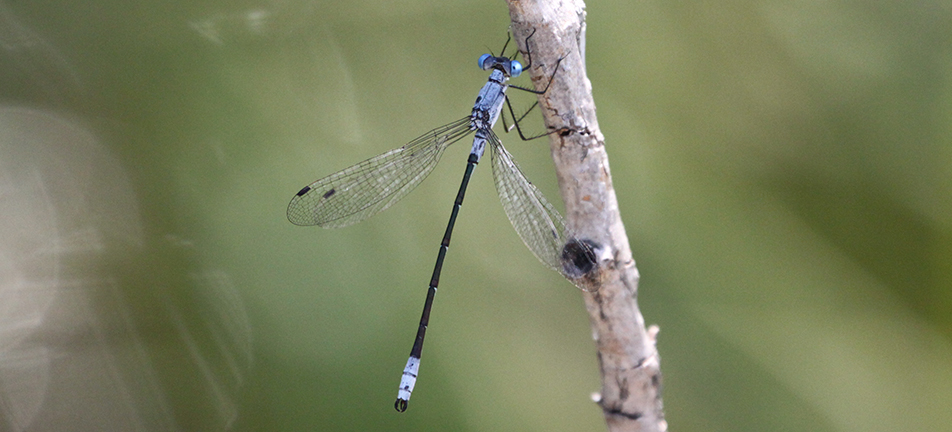
Habitat: temporary and permanent ponds, marshy areas, quiet streams
Flight Season: June to September
Range: southwestern and eastern Ontario, west of Lake Superior south of boreal forest
True Fact: Eggs laid in incisions in live stems of rushes, cattails, sedges and sweetflag up to a metre or two above shallow water or mud.
Scientific name: Lestes rectangularis
Length: 37 – 53 mm
Description: long-bodied and slender, abdomen nearly twice as long as wings, thorax with pale shoulder stripes and yellow sides, lack of pruinosity (a bluish, greyish or whitish, waxy to powdery bloom on the abdomen) at tip of abdomen
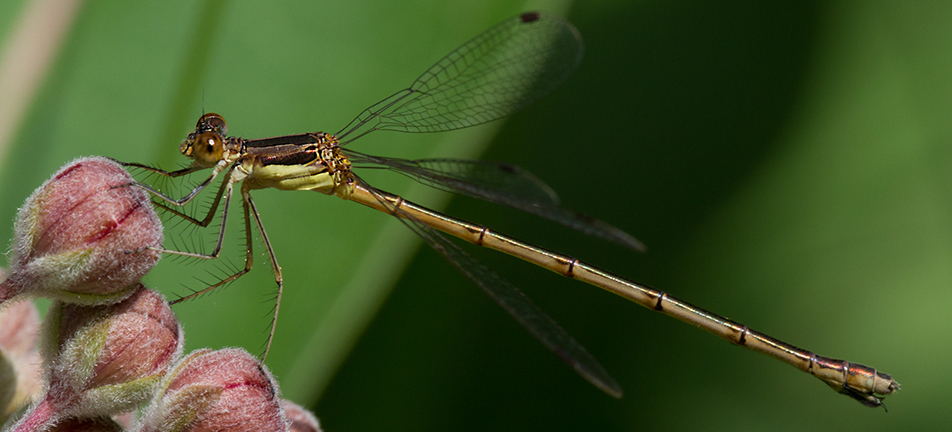
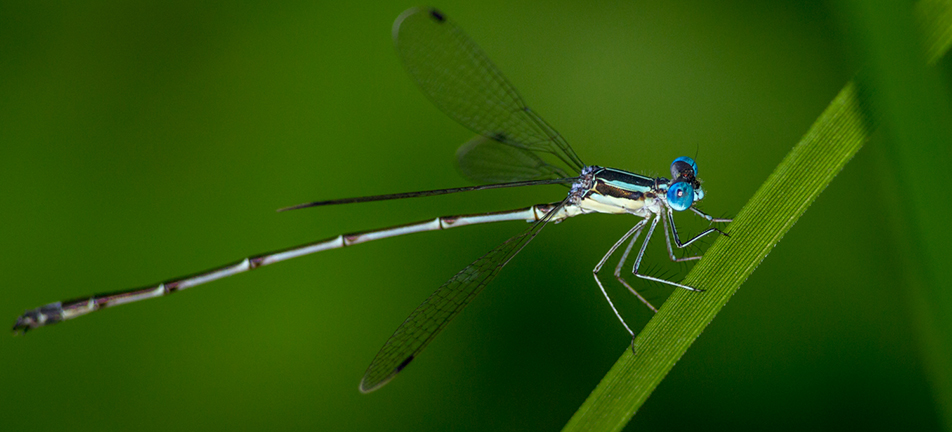
Habitat: shaded ponds or quiet areas of streams, marshy waters
Flight Season: June – October
Range: south-eastern and south-western Ontario
True Fact: This species may emerge in great numbers from some wetlands.
Scientific name: Lestes unguiculatus
Length: 31 – 44 mm
Description: male with blue eyes, covered with powdery bluish-white coloration when mature, separated from other spreadwings by S-shaped terminal appendage on abdomen (hence name “lyre-tipped”); female with blue or brown eyes, much stouter than slender male
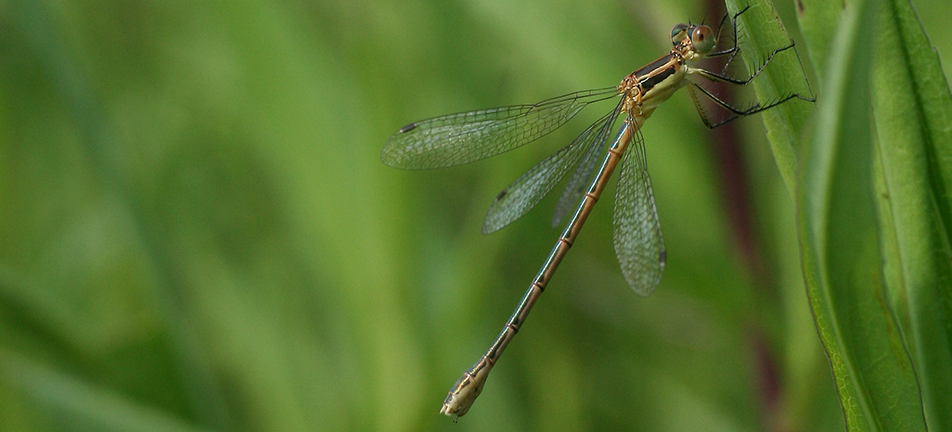

Habitat: open, usually temporary wetlands and ponds
Flight Season: June to September
Range: throughout most of Southern Ontario to northern part of Great Lakes area
True Fact: Population is severely affected by drought, but is quick to populate newly-flooded areas.
Family Coenagrionidae (Pond or Narrow-winged Damselflies)
Species in this large family are small and brightly coloured. They possess clear, narrow wings which appeared stalked at the base and which are held closed over the body.
Scientific name: Argia apicalis
Length: 33 – 40 mm
Description: male: clear blue, unpatterned thorax separates it from other dancers, blue eyes, abdomen with blue tip; female: usually blue to brown
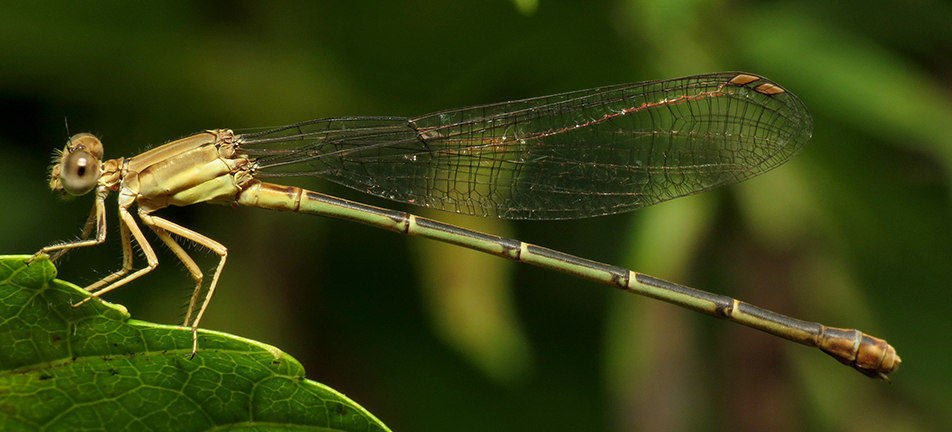
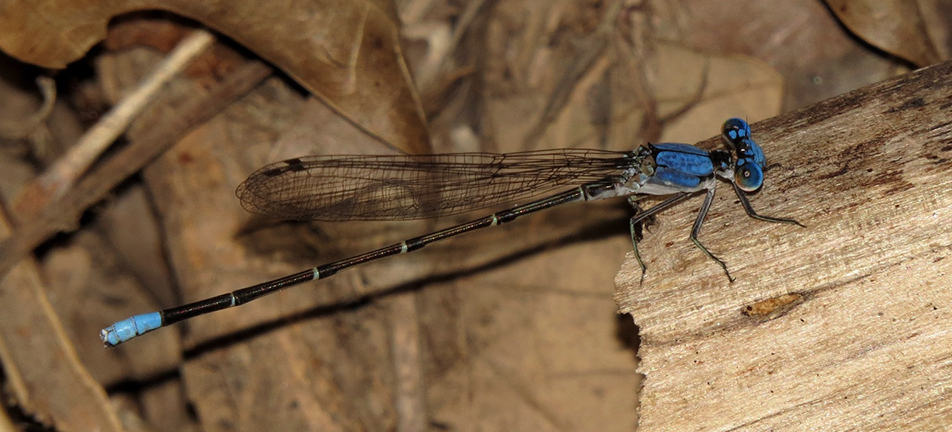
Habitat: rivers and streams, prefers wide muddy rivers
Flight Season: June to August
Range: southwestern Ontario to Lake Simcoe and south
True Fact: Often perches on ground or low in vegetation, pairs usually lay eggs on floating, horizontal material.
Scientific name: Argia fumipennis violacea
Length: 29 – 34 mm
Description: male only damselfly in Ontario with general violet colour, thorax with thin black, forked shoulder stripes and paler sides, abdomen violet with black markings and blue tip; females with brown head, light brown thorax with forked black stripes, brownish abdomen with black stripe
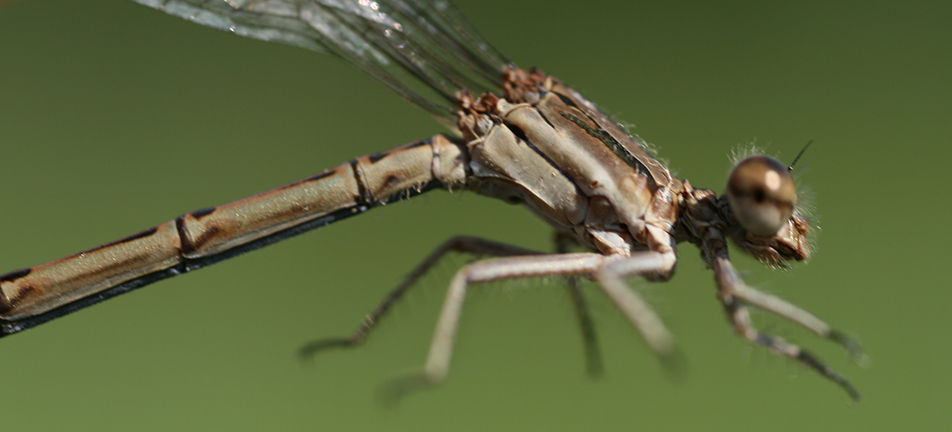
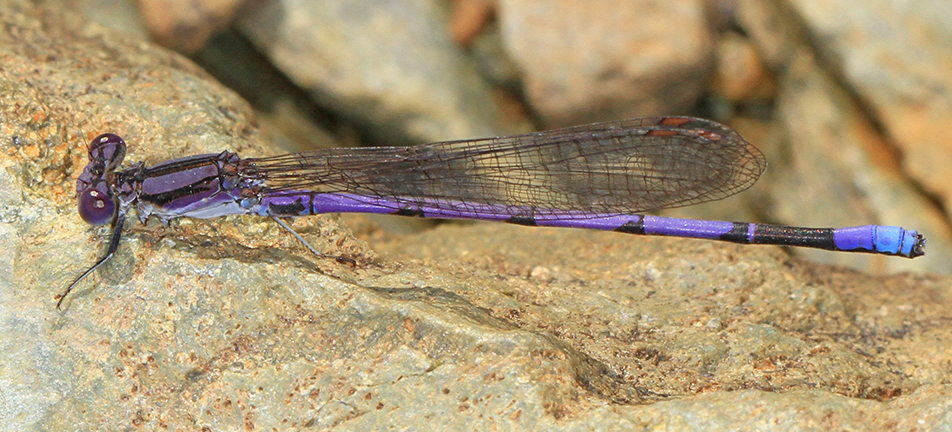
Habitat: small streams, ditches, small ponds with much vegetation
Flight Season: June to September
Range: central, south western and south eastern Ontario
True Fact: Pairs may submerge while laying eggs.
Scientific name: Argia moesta
Length: 37 – 42 mm
Description: mature males become whitish, abdomen blackish with paler tip; females have two colour forms (polymorphic), either completely brown, or dark blue on head, thorax and tip of abdomen
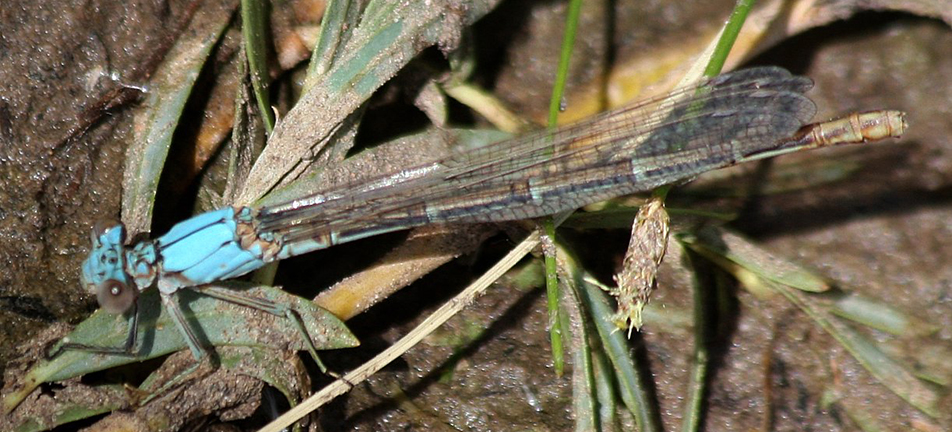
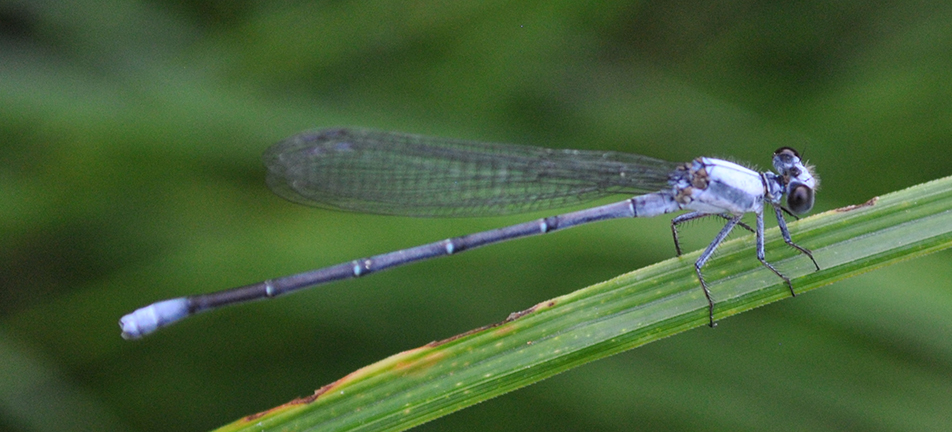
Habitat: prefers rocky shores of lakes, streams and rivers
Flight Season: June to September
Range: central, south western and south eastern Ontario, west to Manitoba south of boreal forest
True Fact: Pairs or female alone lay eggs on surface or submerged for up to 30 minutes and more than a metre under water, females may eat other damselflies including their own species
Scientific name: Enallagma antennatum
Length: 27 – 33 mm
Description: male is distinguished by combination of orange colour on face, greenish thorax with black shoulder stripes, and blue abdomen (darker above), fine black stripe on yellow legs;Female pale yellowish green, thorax and abdomen dark above

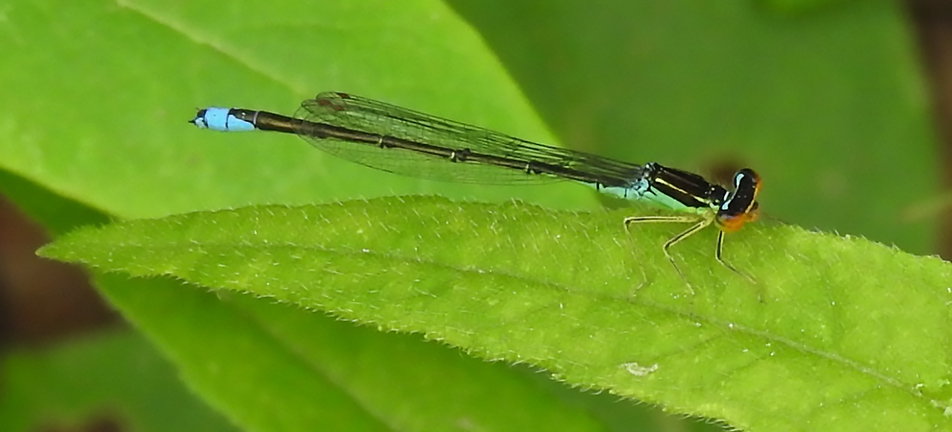
Habitat: quiet streams and rivers with emergent vegetation along edge, also lakes especially near stream inlets or outlets
Flight Season: June to August
Range: south-eastern and south-western Ontario
True Fact: Females of this species have been reported to submerge to lay eggs, pairs oviposit along edge of water in vegetation
Scientific name: Enallagma carunculatum
Length: 26 – 37 mm
Description: commonly found in marshes in the north; males eyes blue with black top, blue thorax broadly striped with black, abdomen with black patches(approximately equal amount of black and blue); female: may be brown or blue
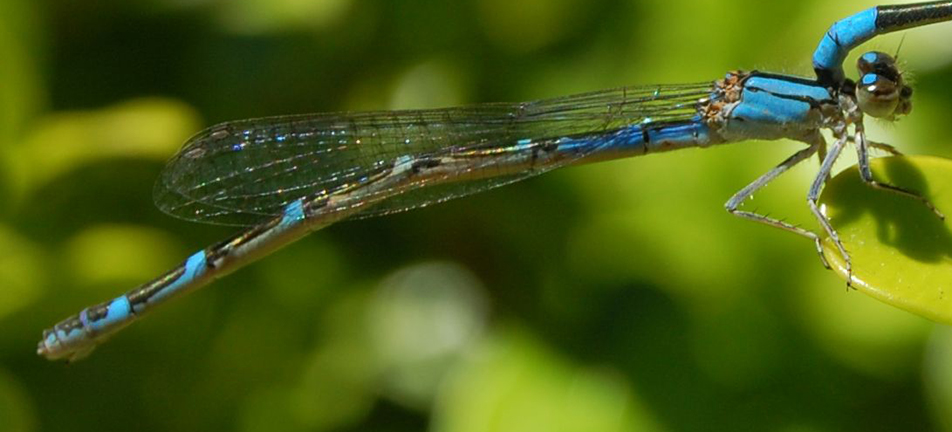
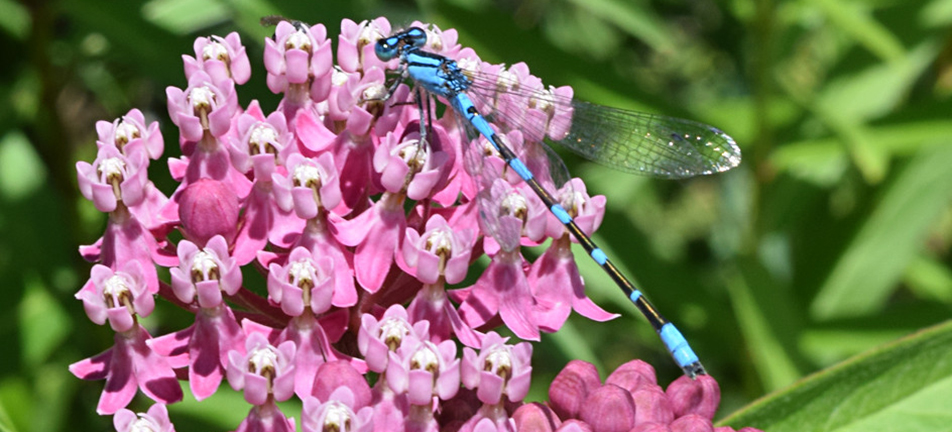
Habitat: slow streams and rivers, ponds and lakes especially where cattails present
Flight Season: June to September
Range: central and south western Ontario, also Lake of the Woods regions west of Lake Superior
True Fact: Major predator of mayflies and small flies, may be seen on wing well out over open water.
Scientific name: Enallagma boreale
Length: 28 – 36 mm
Description: male has blue eyes with black cap, abdomen predominantly blue with faint dots in blue near tip of abdomen; female: may be brown or blue
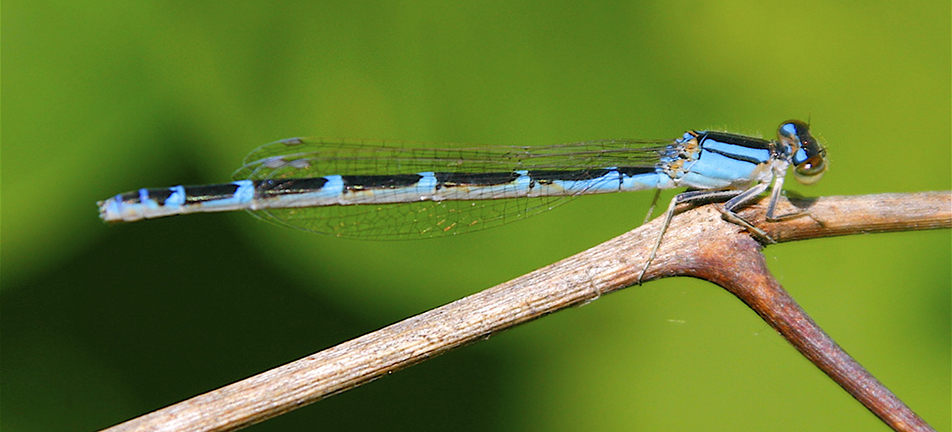
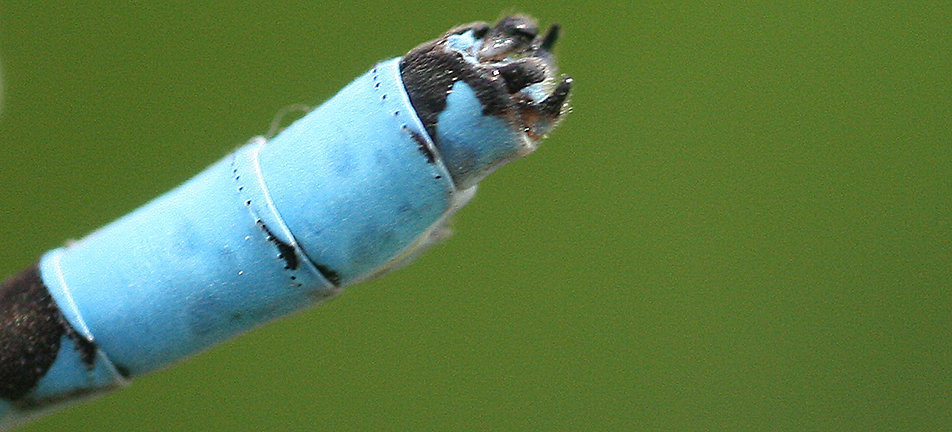
Habitat: boggy or marshy lakes, ponds and slow stream
Flight Season: May to August
Range: present throughout Ontario, but more common in the north
True Fact: Sometimes are numerous in open areas of forests.
Scientific name: Enallagma civile
Length: 28 – 39 mm
Description: abundant and widespread, mostly blue with fairly thin black humeral stripe on thorax, post-ocular spots (behind front of eyes) rather large and somewhat triangular, long cerci (appendages beyond abdomen) visible with good dorsal view; females similar pattern but may be brown or blue
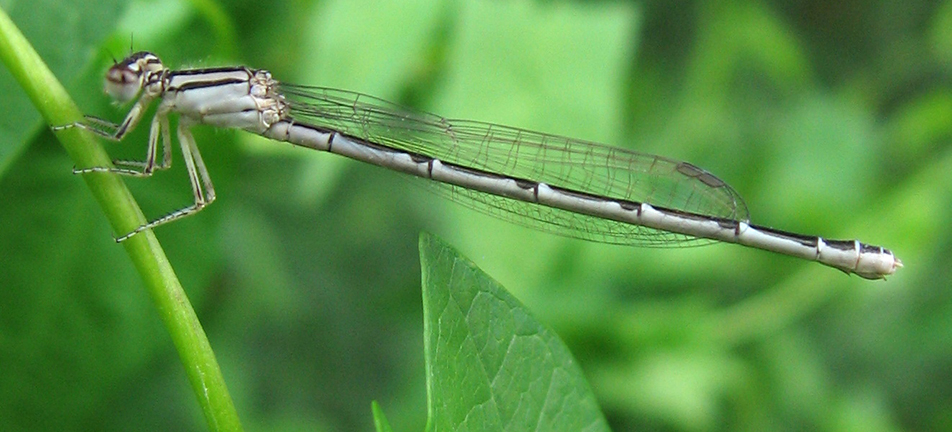
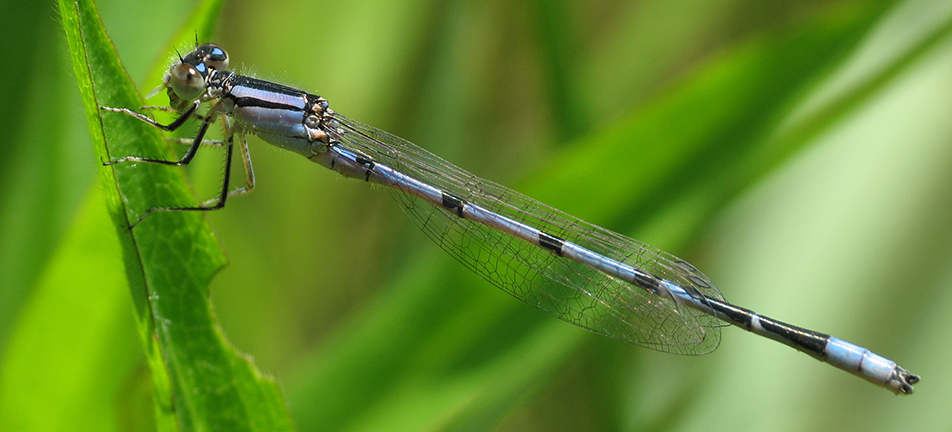
Habitat: standing or slow-moving water such as ponds or slow streams, also newly-created habitats
Flight Season: May to October
Range: south eastern and south western Ontario
True Fact: This species may be extremely abundant at some sites. The males arrive at water and remain in large numbers until late afternoon. Mating is most frequent around mid-day. During egg-laying, the female backs underwater while the pair is in tandem, but the male releases her before his head submerges, clasping her again when she surfaces.
Scientific name: Coenagrion interrogatum
Length: 28 – 33 mm
Description: far northern species, both sexes with wide blue shoulder stripes, usually divided into two rectangles and two squares, male with eyes black over blue, alternating blue and black abdomen, female duller than male, may be blue or green
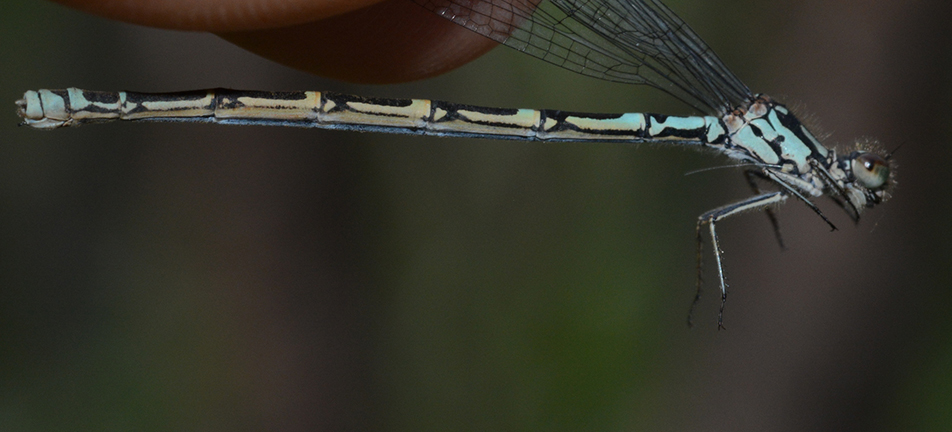
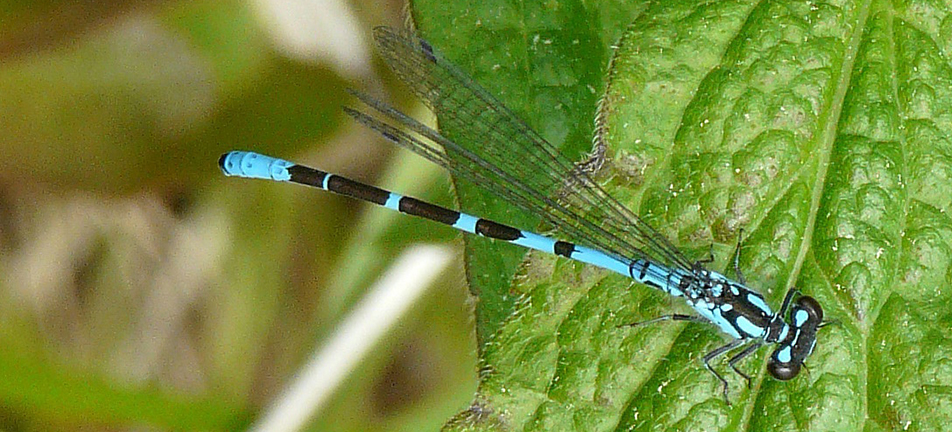
Habitat: fens, bogs and marshes especially when sphagnum moss is present
Flight Season: June to July
Range: northern and north western Ontario, absent from southeastern and southwestern Ontario
True Fact: This species has the most northerly range of the bluets. Copulating pairs of this species often perch in shrubs as high as head height.
Scientific name: Enallagma ebrium
Length: 28 – 34 mm
Description: very common in northern areas; male mostly blue colouration, distinguished from Boreal, Northern and Familiar bluets by teardrop-shaped spots behind eyes joined by a small occipital bar resembling a dumbbell, distinguished from Hagen’s bluet by C-shaped terminal appendages
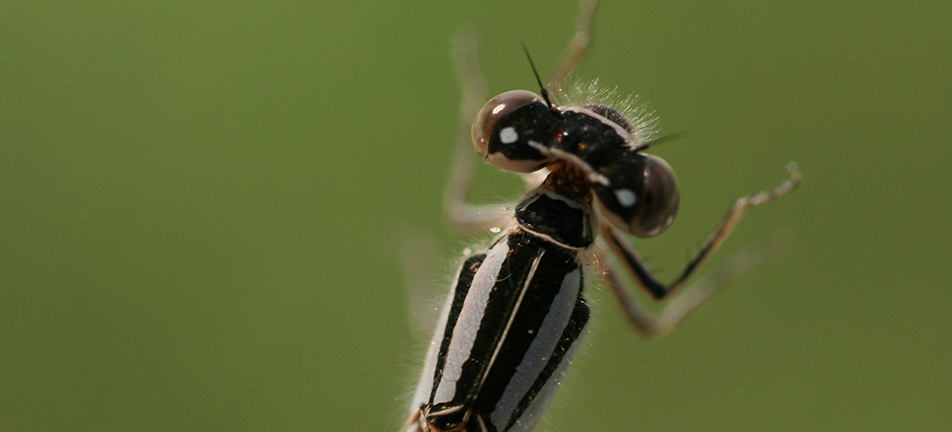
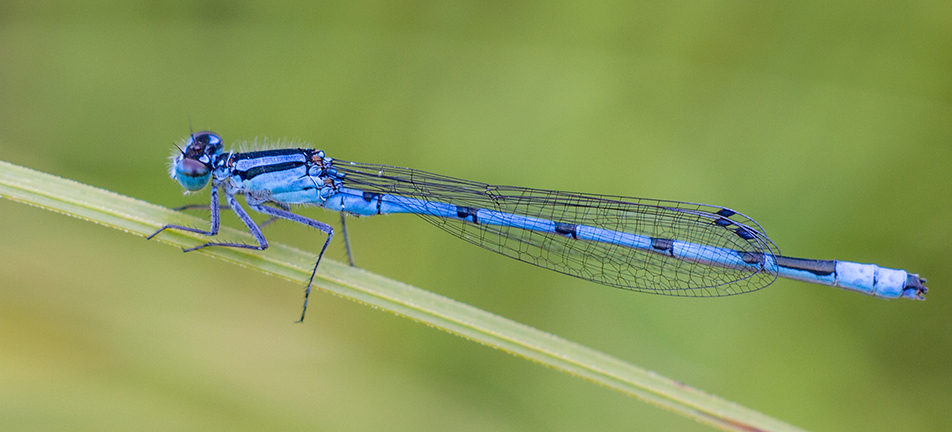
Habitat: lakes, marshes, ponds and quiet streams
Flight Season: May to September
Range: Ontario north to southern tip of James Bay, in northwest to Manitoba south of the boreal forest region
True Fact: Males may be found in large numbers perching on shoreline plants or mats of algae, not usually found over open water.
Scientific name: Enallagma exsulans
Length: 31 – 37 mm
Description: slender bluet, usually around streams and rivers, abdomen primarily black with blue near tip, greenish hue on thorax and head, spots behind eyes narrowly connected to form a narrow dumbbell shape
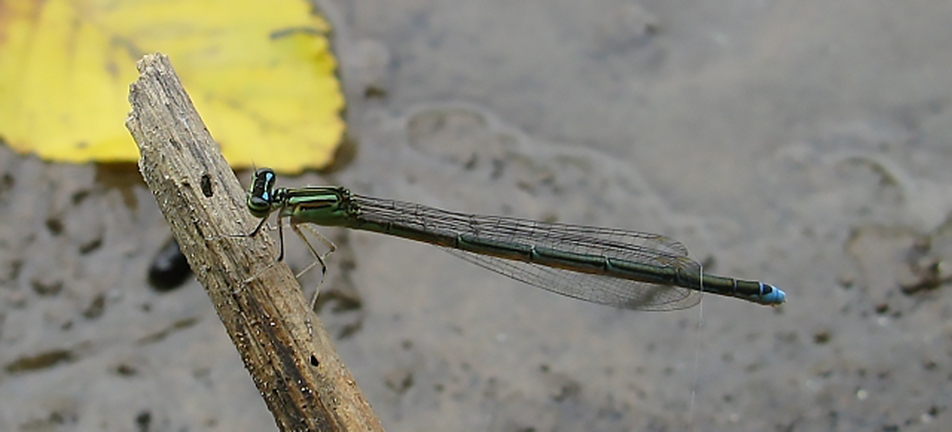

Habitat: prefers streams and rivers
Flight Season: June to September
Range: southern Ontario to north shore of Georgian Bay, absent
Scientific name: Enallagma hageni
Length: 27 – 33 mm
Description: small, common bluet especially in northern areas, postocular spots (behind eyes) show as a dumbbell shape; male eyes blue with black cap, striped blue and black thorax, abdomen alternates black and blue; female may be light brown, green or blue, eyes light brown or greenish with brown cap
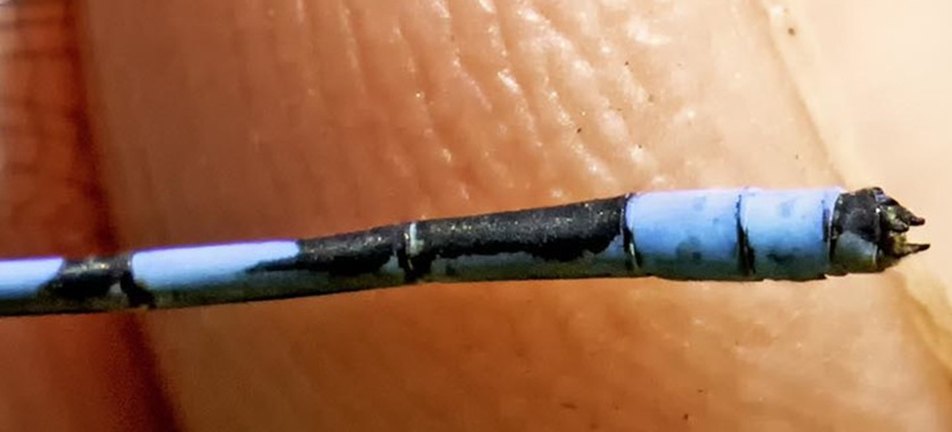
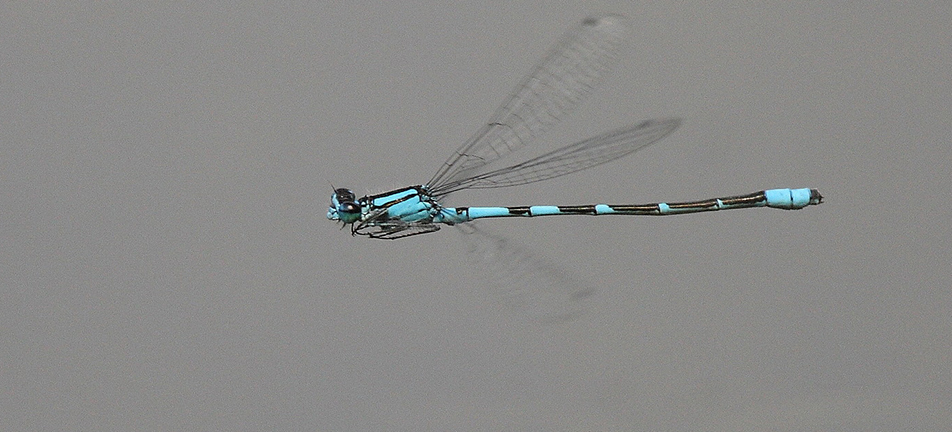
Similar Species: almost identical to Marsh Bluet, only differ in shape of terminal appendages
Habitat: ponds, marsh-bordered lakes, quiet streams
Flight Season: May to September
Range: throughout Ontario south of boreal forest region
True Fact: During egg-laying, like several other bluets the female will submerge, crawling around underwater vegetation.Upon resurfacing, the waiting male (or another) will re-attach to form a tandem pair again.Males seem to act as lifeguards, pulling floating females from water (for the purpose of mating, of course!).
Scientific name: Enallagma signatum
Length: 28 – 37 mm
Description: male eyes orange, thorax orange with black stripes, abdomen mostly black with orange rings, female similar pattern but brown eyes and dull yellow to orange in paler areas, young adults may be blue
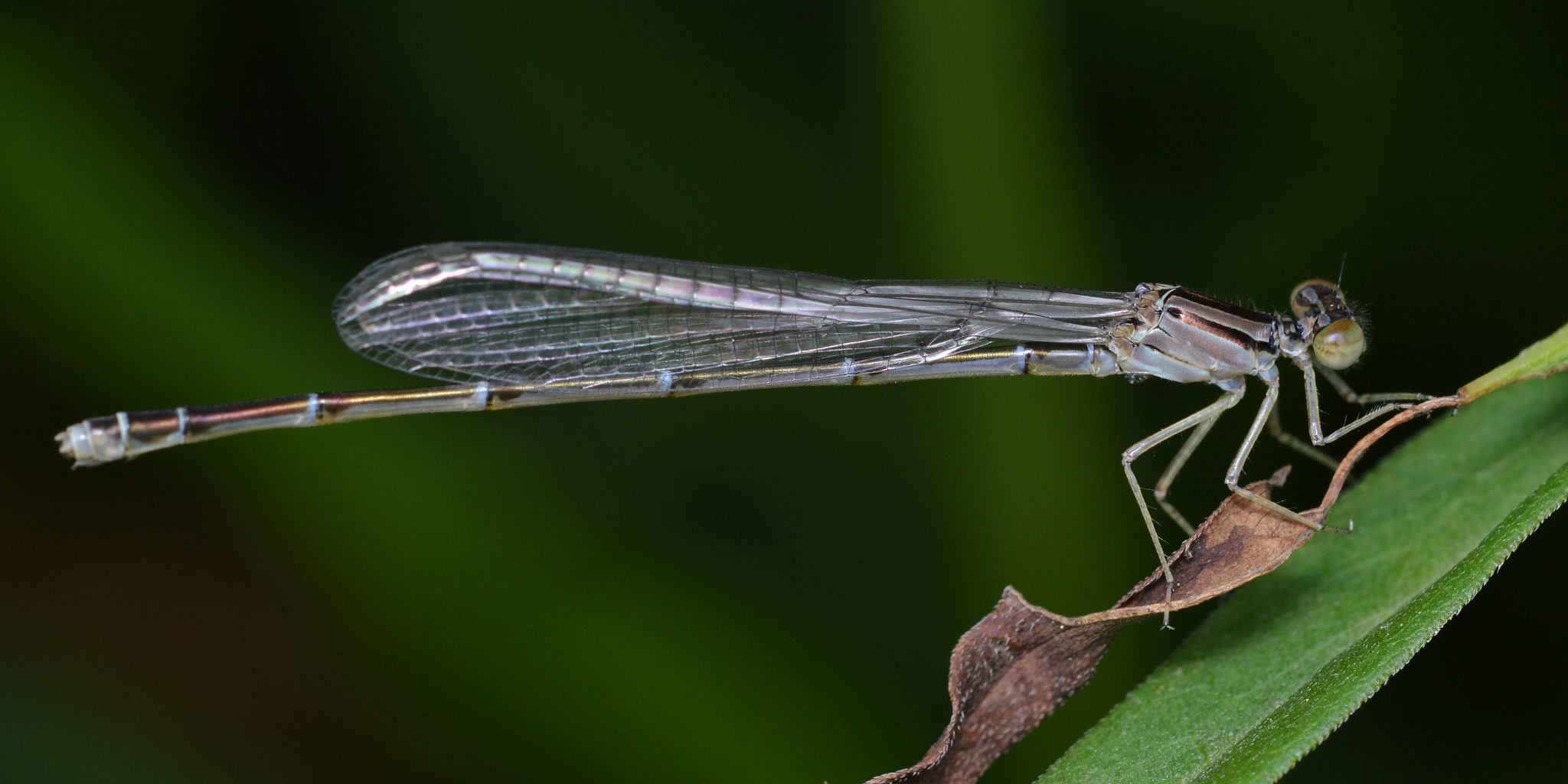
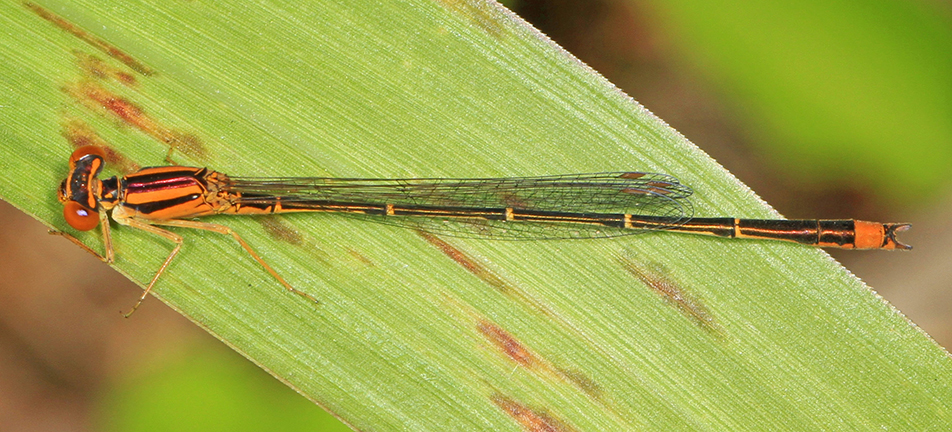
Habitat: lakes, ponds, slow streams, and tolerates somewhat polluted areas
Flight Season: June to October
Range: central, south eastern and south western Ontario
True Fact: At water, this species’ peak activity is late afternoon, and stays active until dark.Females or even the pair in tandem may submerge during egg-laying for ten to twenty minutes.
Scientific name: Ishnura verticalis
Length: 29 – 33 mm
Description: male thorax is yellowish green with black stripes; yellowish-green abdomen is black on top and ends with a blue and black patterned tip; adult females are a powdery purplish-blue with variable black markings; young females are orange with black markings

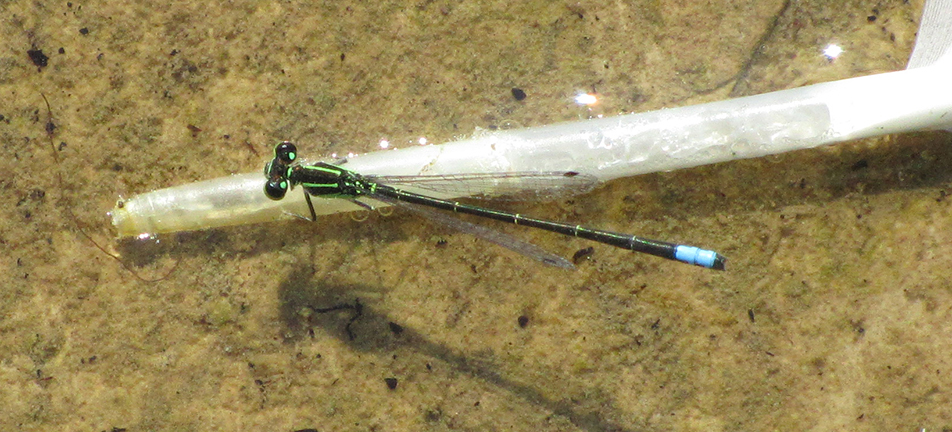
Habitat: this damselfly is found in most wetlands
Flight Season: May to October
Range: southern half of Ontario
True Fact: This species is one of our most common damselflies. It can be seen quite far from water.
Scientific name: Nehalennia irene
Length: 26 – 27 mm
Description: male; metallic green above and light blue below; the tip of the abdomen is blue with metallic green spots; female is similar to the male but yellowish underparts and with only a small bit of blue on the tip of the abdomen
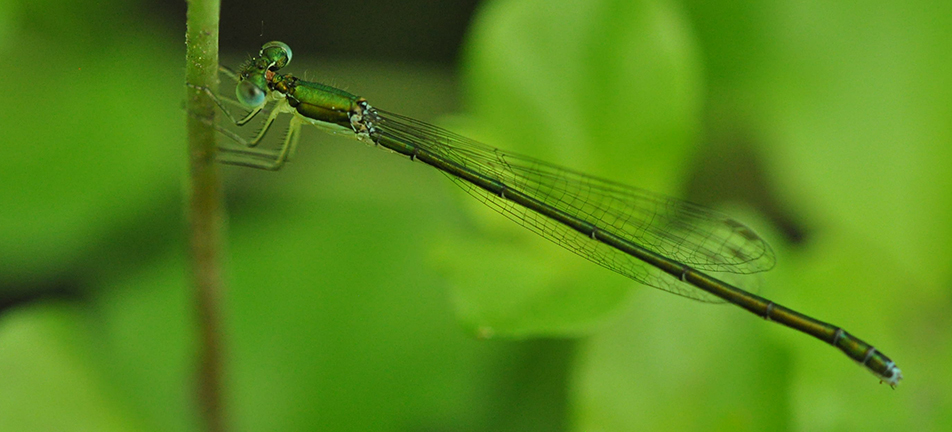
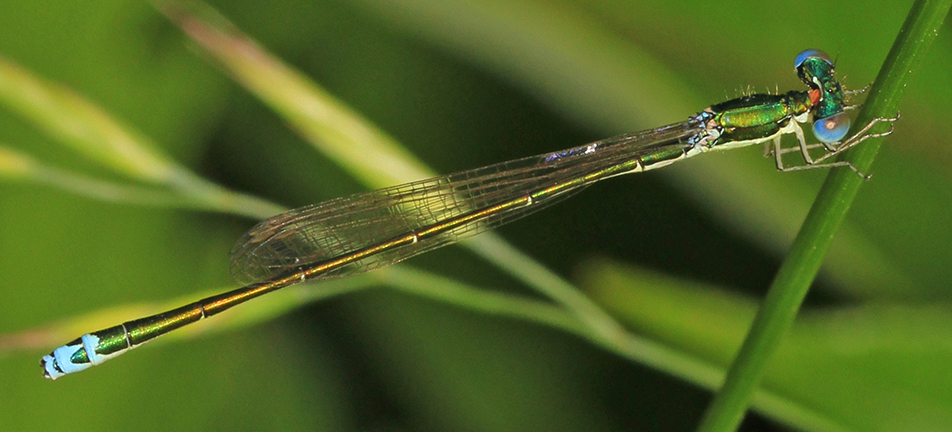
Habitat: vegetated wetlands and damp fields
Flight Season: June to August
Range: southern two-thirds of Ontario
True Fact: In some locations, this tiny damselfly can be very abundant but hard to see amongst the vegetation.
Authors: Dan Schneider and Peter Pautler
Dan Schneider is an interpretive naturalist and outdoor education teacher with the Grand River Conservation Authority.
Peter Paulter is an environmental education specialists with the Grand River Conservation Authority.
Original Dragonflies ON Nature article author: Nancy Clark
Contributor: Noah Cole

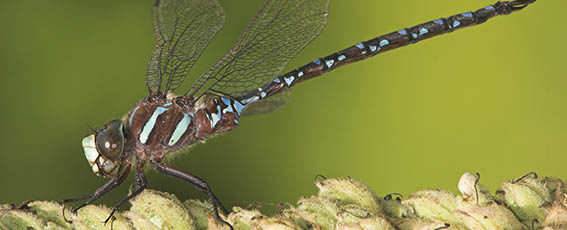
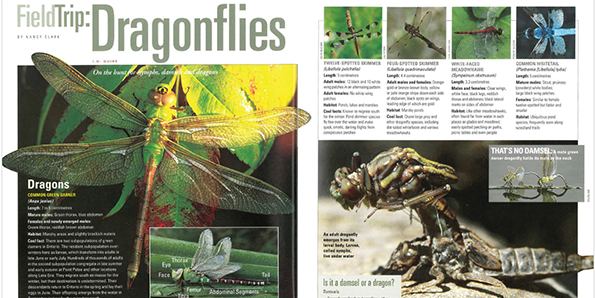
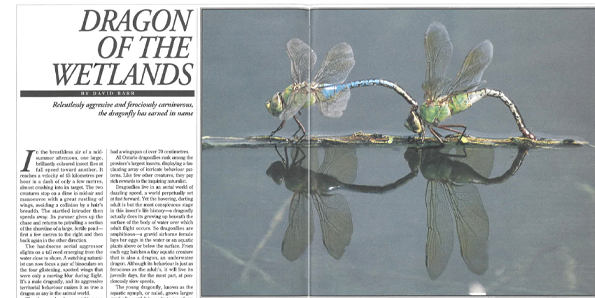
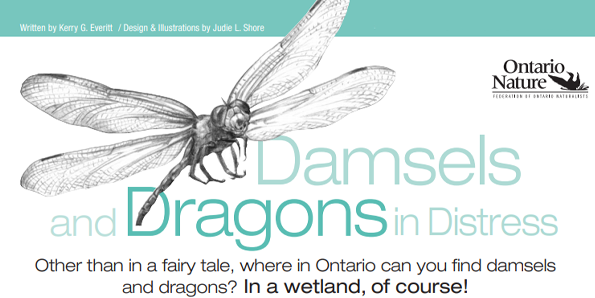
Lovely. Encountered an EBONY JEWELWING damselfly some distance removed from Sawmill Creek in a white pine & silver maple woodland sun-dappled opening on June 19, 2024 in the old farm estate of the Dunn Family called Dunn Park, City of Mississauga. The delightful creature was a female. Plenty of mosquitoes about for it to eat!